A Flaming Sword in the Sky
Here’s another one of those short promo videos for the current show. You can find more of them on the Bone and Sickle YouTube channel if you’re interested.
Here’s another one of those short promo videos for the current show. You can find more of them on the Bone and Sickle YouTube channel if you’re interested.
And happy 1-year birthday to Bone & Sickle!! A little video to celebrate:
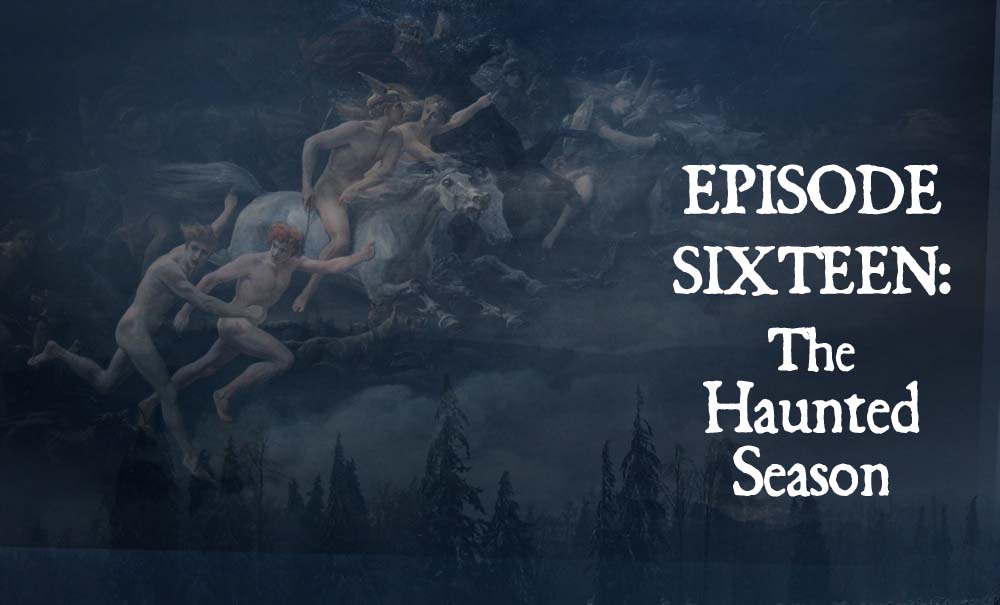
Podcast: Play in new window | Download (Duration: 37:27 — 51.4MB)
Subscribe: Apple Podcasts | Spotify | Android | Podchaser | RSS | More
Historically, Christmastime in Central Europe was a season haunted by otherworldly spirits, werewolves, ghostly huntsmen, and wandering hordes of lost souls. This is particularly the case in the Krampus’ homeland of German-speaking Central Europe.
We open with a survey of the various frightful spirits said to be afoot this time of year. Bavaria, particularly the Bavarian Forest turn out to be particularly rich in such things, menaced by everything from spirits of the forests (Schratzn) and marshes to entities said to reside in mills, and historic castles. Historical figures with unsavory reputations including the legendary cowherd Woidhaus-Mich, Chatelaine Maria Freiin of Castle Rammelsberg and the Bavarian outsider prophet Mühlhiasl of Apoig are said to return as evil spirits this time of year. We hear a brief clip from Werner Herzog’s 1976 production, Heart of Glass, a lovely and peculiar treatment of Mühlhiasl’s story.
Just as the Krampus appears as an evil counterpart to St. Nicholas on his feast day (and its eve), we encounter other frightful creatures from German culture said to represent similarly sinister incarnations of other saints celebrated in December. From the Upper Allgäu region of the Bavarian Alps, there are the moss-encrusted Bärbele (“Barbaras”), or sometimes “Wild Barbaras,” and throughout Bavaria and Austria, St. Lucy was also inverted on her day (Dec. 13) as the “Luz,” or “ugly Lucy,” an entity particularly hungry for blood and ghastly punishments. We also meet “Bloody Thomas,” a figure appearing on the eve or night of St. Thomas Day, December 21.
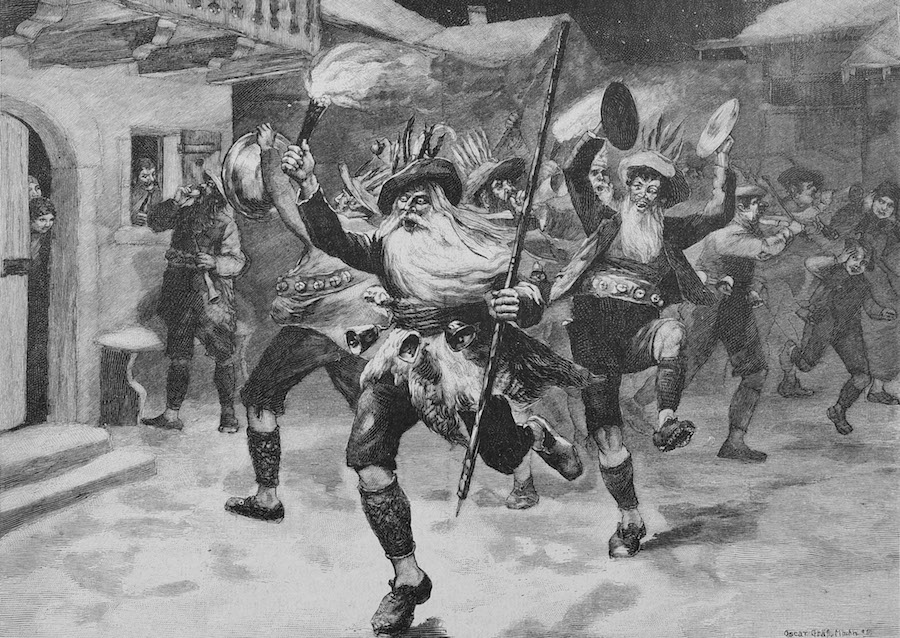
Next we consider a raft of superstitions associated with the Twelve Nights, or Rauhnächte, a name likely derived from the German word for “smoke” (Rauch) thanks to the use of incense during these nights to dispel evil influences.
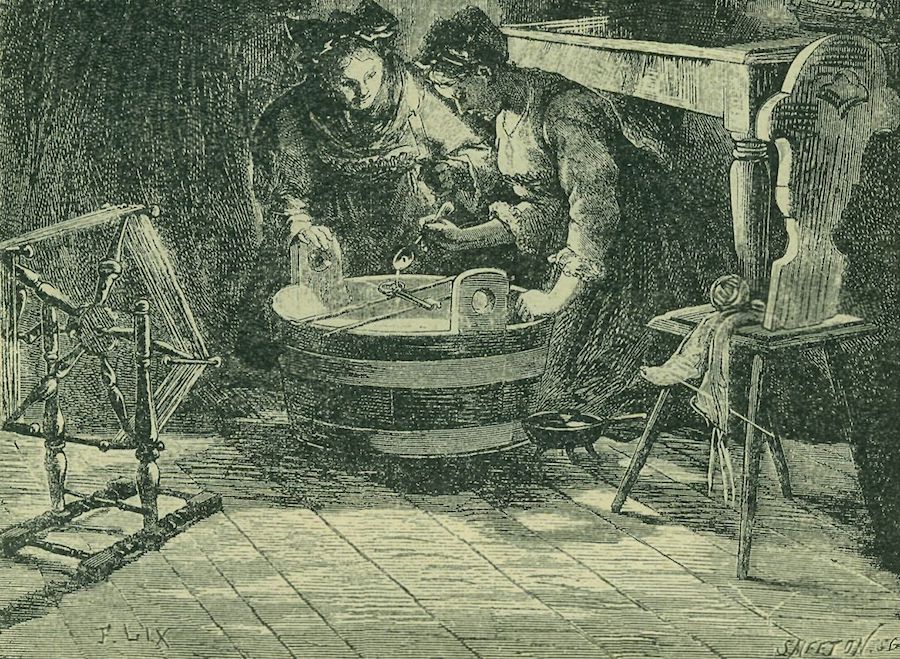
Of all the terrors unleashed during the nights around Christmas, the most widespread in German-speaking lands were those ghostly hordes in nocturnal processions, dead souls, solemnly walking, or wildly riding, the latter usually going under the name of “Wild Hunt” or “Furious Army.” This mythologem is prevalent throughout Central Europe, Scandinavia, the British Isles, and even North America, where the spirits appear in cowboy legends, and made their way into the 1940s country-western ballad “(Ghost) Riders in the Sky.”
Wilkinson reads for us some rather dramatic (and grisly) accounts of this form of apparition from the 16th century, and we hear a variety of accounts emphasizing the weird sounds that were said to accompany the Wild Hunt.
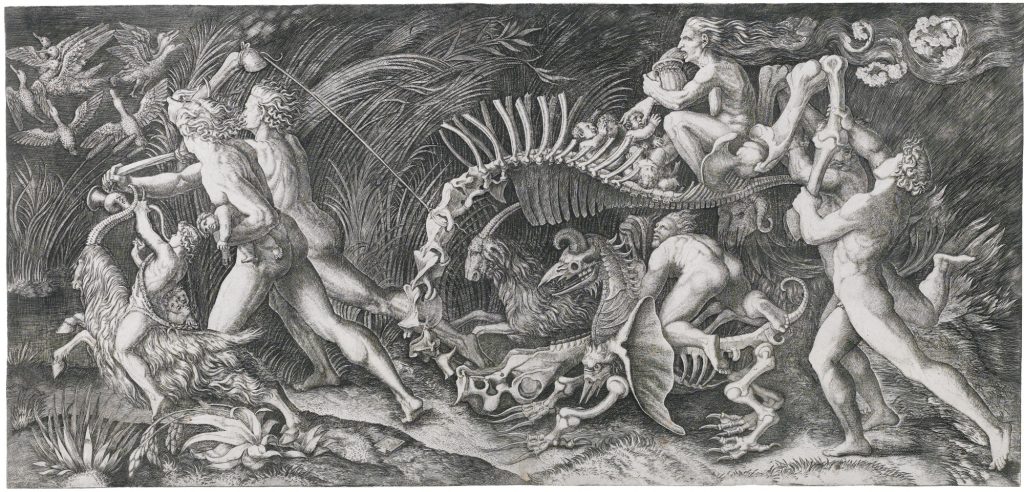
A number of figures were presented as the leader of the Wild Hunt, in particular the Germanic god, Odin, whose presence was associated with the superstition all the way into the 1800s as we hear from a newspaper account of the period.
We close the show with some folk tales recounting a similar phenomena in Austria and Switzerland, namely tales of the “Night Folk,” or “Death Folk,” nocturnal hordes whose appearance often heralded death or misfortunes.
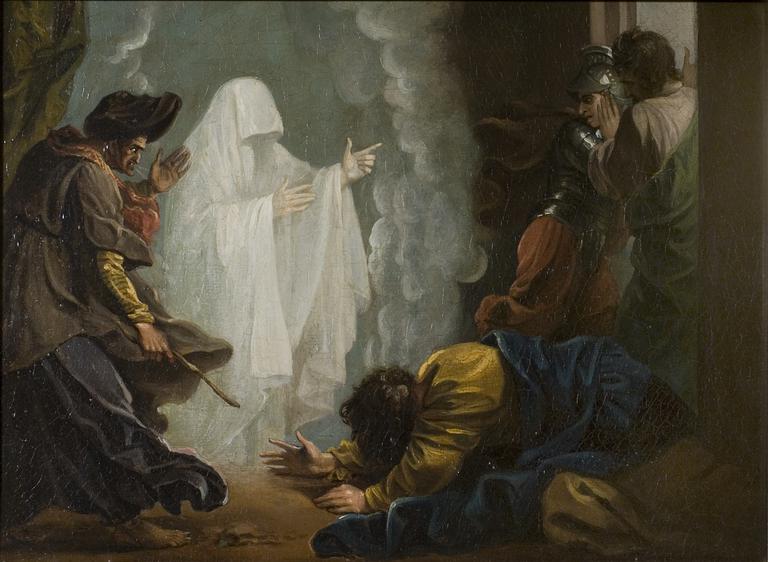
To thank you for all your patience through September, we’re giving you THREE Bone & Sickle episodes for this Halloween month — all about speaking with the spirits of the dead.
Monday, October 8
EPISODE 11: THE DEAD SPEAK
Early Spiritualism. Ectoplasmic shenanigans. Vaudevillian seance shows. A “spirit machine. Tricks of the trade and compromising positions. A ghostly dream and a grisly punishment.
Monday, October 15
EPISODE 12: SEANCES AND SCANDALS
Early 20th-century attempts to record spirit voices. Seance nudity and birthing an ectoplasmic egg. A stolen “spirit baby,” and the murderous ghost of a Neanderthal.
EPISODE 11: ANCIENT RITES OF NECROMANCY
Talking to the dead in antiquity. What turned “black magic” black? A Roman graveyard witch. Walled up alive by a Greek ghost. Fresh blood and body parts. Figures in a mirror.
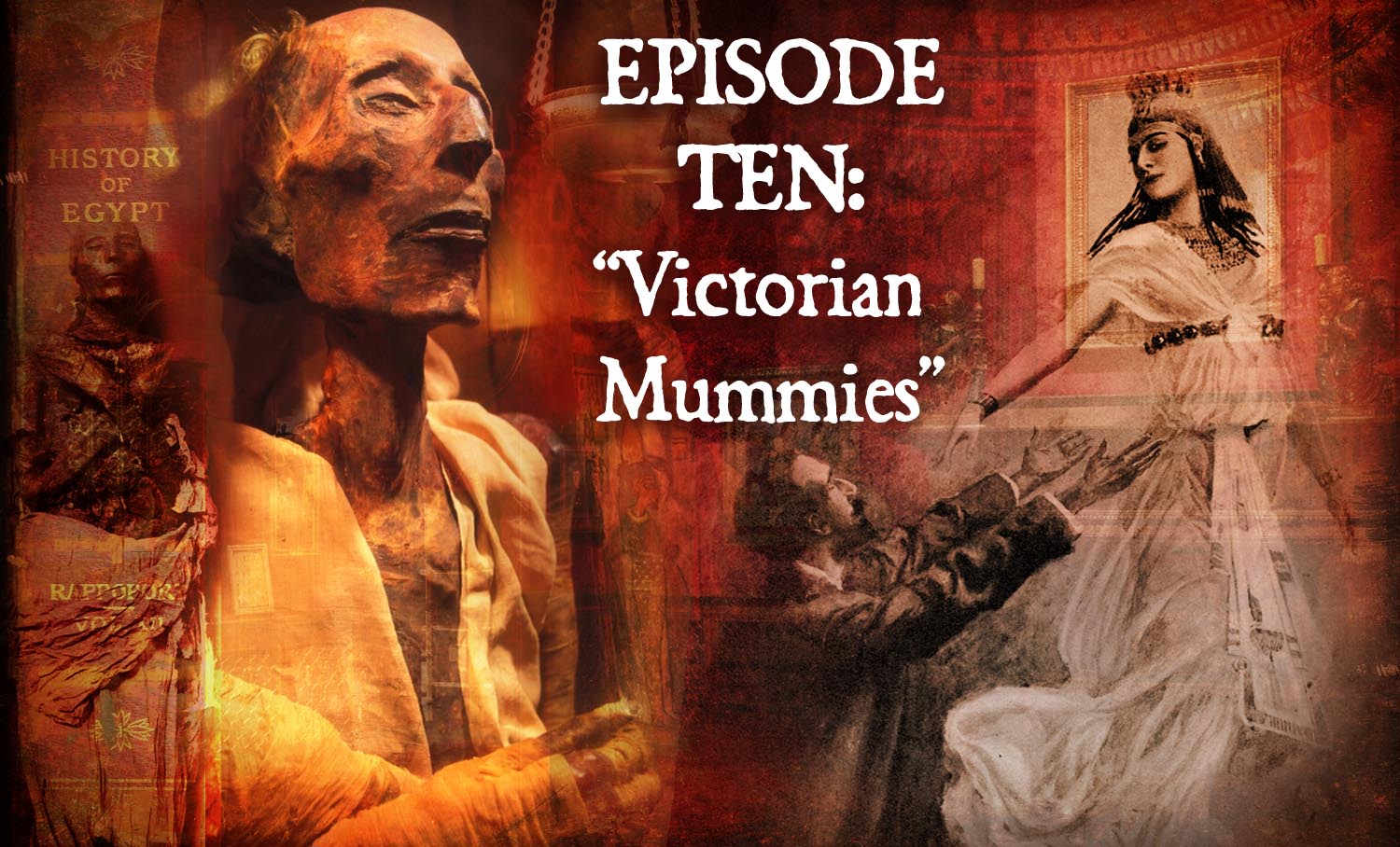
Podcast: Play in new window | Download (Duration: 53:30 — 98.0MB)
Subscribe: Apple Podcasts | Spotify | Android | Podchaser | RSS | More
This time round we explore the way in which the death-obsessed Victorians fetishized the equally death-obsessed Egyptians, creating a number of gothic mummy tales, which often veer into storylines that are almost necrophilic.
To begin we have a look at how the Victorians interacted with mummies as artifacts. We hear an 1899 story from Philadelphia’s The Times making clear that the demand for mummies as displays for educational institutions and even as curios for private homes of the well-to-do, was so great that entrepreneurial types in Egypt came up with rather unsavory ways of meeting the needs of the market.
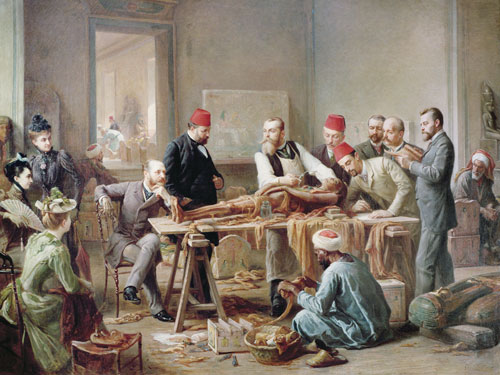
We discuss Thomas Pettigrew and his promotion, not only of “mummy unwrapping” parties in the 1830s and ’40s, but also of the “miracle” of germinating seeds or “mummy wheat” allegedly found in ancient tombs. A peculiar story of a Scottish duke and his morbid preoccupation with Pettigrew’s mummy ballyhoo should also be of interest to listeners.
Wilkinson narrates a first-person experience of a mummy unwrapping during a thunderstorm penned by French RomanticThéophile Gautier, author of a number of mummy stories himself. His short, supernatural story, “The Mummy’s Foot,” is the first of several included in this episode that connect grotesque mummified remains (a foot in this case) with a rather comely, female love interest. One likely explanation for this tendency is offered via a short side-trip to French Orientalist art and Victorian pornography.
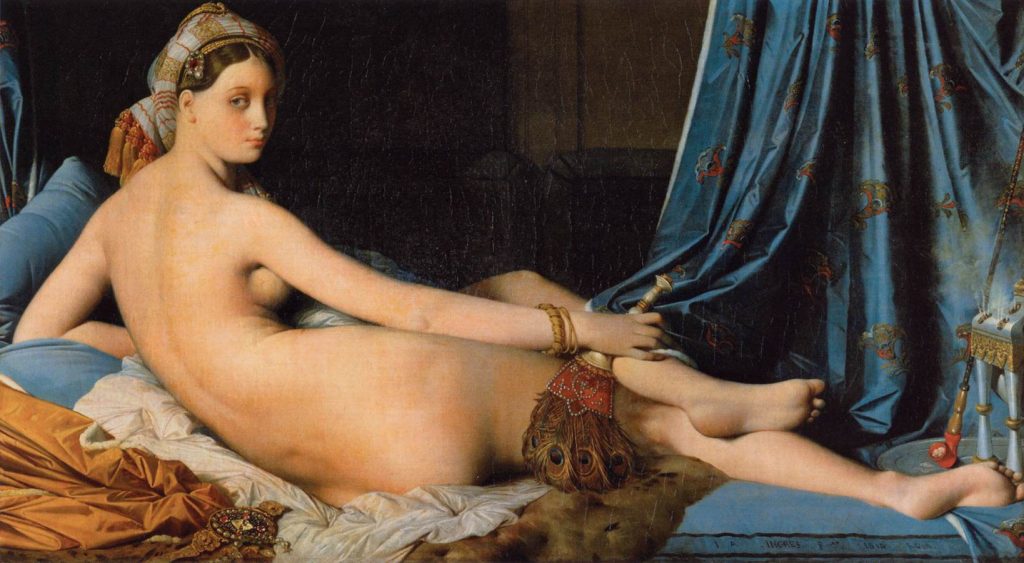
Next we explore The Jewel of Seven Stars, written in 1903 by Bram Stoker. This one also centers upon a regal Egyptian female (a queen and “sorceress”) who is missing an appendage — a hand in this case, which is wearing a ring with the valuable, titular “jewel.” The “seven stars,” we learn, wre lamps from the mummy’s tomb, which are to be used in an occult experiment to raise the spirit of the ancient queen. A mummified cat — much like the one recently gifted to the Bone & Sickle Library by Paul Koudounaris — also plays an interesting role in the story. Wilkinson narrates another strangely eroticized unwrapping scene from the novel, and there are snippets from the surprising number of films adapted from this previously neglected work.
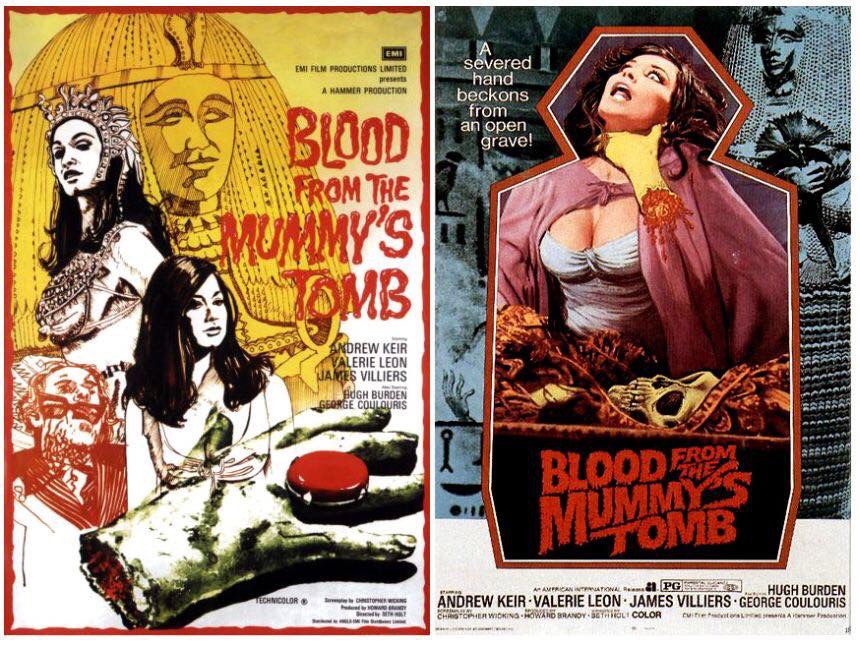
Then we’re off to the manly adventure-world of H. Rider Haggard who once delighted British audiences with tales of stiff-lipped men taming the Empire — and occasionally venturing into lost subterranean worlds, as in the novel She, which we discuss as another case related to the “seductive mummy” trope. Haggard’s stories generally, have more in common, perhaps, with the Indiana Jones model, but She crosses some paths with horror and science fiction, and was adapted for film by both Merian C. Cooper (director of the original King Kong) and British Lion (with Peter Cushing and Christopher Lee).
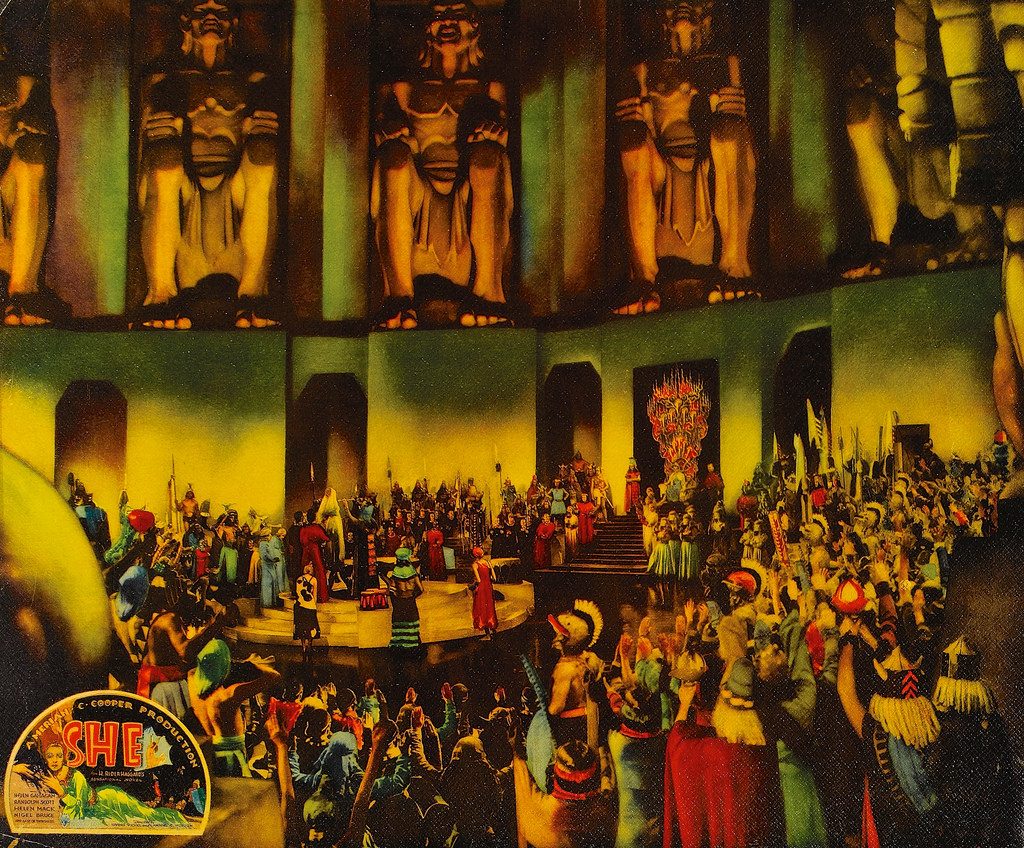
A fair bit of the show is devoted to Arthur Conan Doyle’s interest in mummies, both as fictional devices and in real life. Doyle believed both in the much disputed curse upon Howard Carter’s King Tut outing and another case, the “Ingram mummy,” which happens to also have wound its way into the folklore of The Titanic.
Doyle never signed on as a member, but did attend some meetings of the Hermetic Order of the Golden Dawn, an occult organization popular in Edwardian literary circles and named for Hermes, more or less a Greek version of the Egyptian Thoth. We have a look at how this occult body, and many others, were influenced by Egyptian mythology and how a French novel from 1731 purporting to be the text of a newly translated papyrus shaped their ritual structure. Connections between Egypt, the Tarot, Crowley, and his religion of Thelema are also briefly discussed.
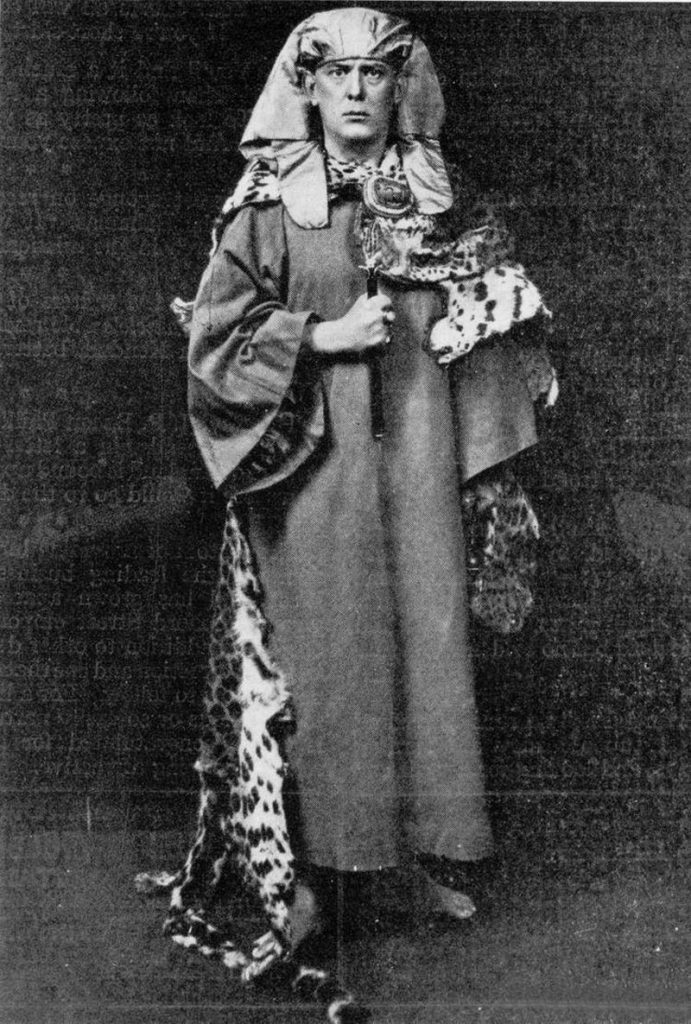
Lots of missing mummy appendages in this episode! The self-described “seer” and palmist going by the name “Cheiro” brings us another tale of a cursed mummy’s hand he supposedly kept in a wall safe for decades. He, like Doyle, also had some things to say about the Tut curse, lessons learned supposedly from a dramatic incident with this mummy’s hand.
Rising to fame in turn-of-the-century Britain, Cheiro migrated to Hollywood, where his later years were spent telling fortunes of the film stars of the 1920s and 30s, and where the idea of the cinematic mummy tale was first developed.
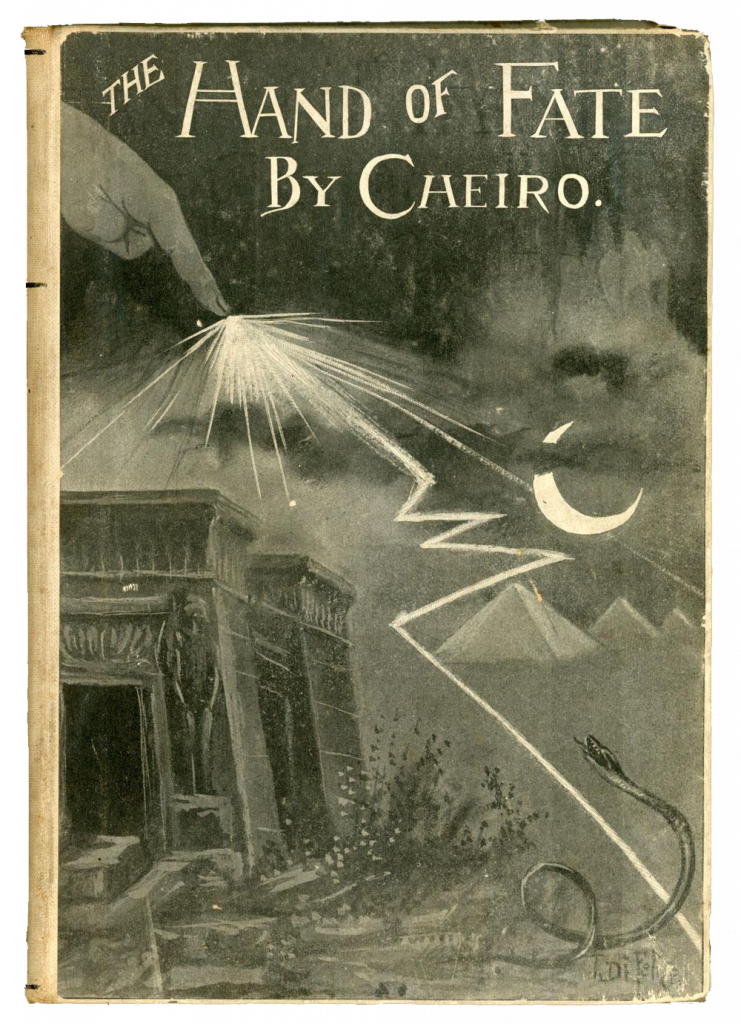
Having provided some background in the curse legends and literary mummy tales of Victorian and Edwardian era, we look at ways in which Doyle’s stories, particularly “Lot 249” might have been an influence on the Boris Karloff film The Mummy from 1932 as well as mummy films of the 1940s through 1960s. A few stray examples from later years are also included.
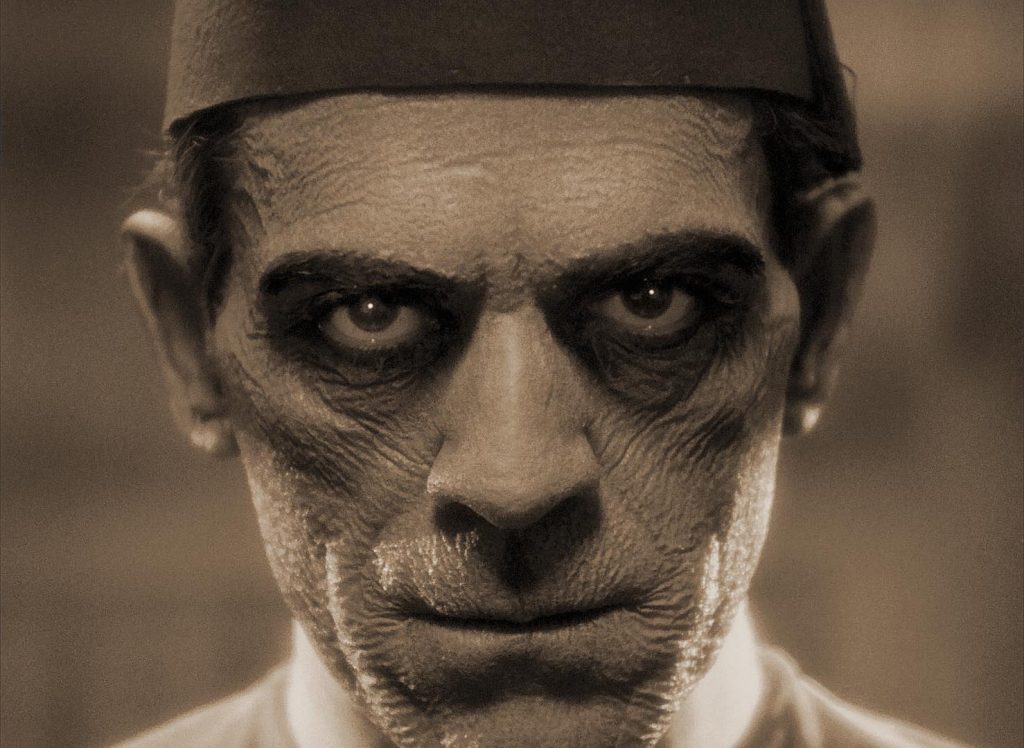
Snippets of two old, Egyptian themed recordings were used in the episode Esther Walker’s “Sahara” from 1919 and “Old King Tut” by Billy Jones and Ernest Hare from 1923.
LISTENER NOTE: Episode Ten is an extra-long deluxe episode wrapping up our Spring-Summer season. Wilkinson and I will be taking off September and returning in October with the folklore of the Fall-Winter season, Halloween, the Krampus, and more. We suggest you check back here, or even better, subscribe, so you know when we’re back.
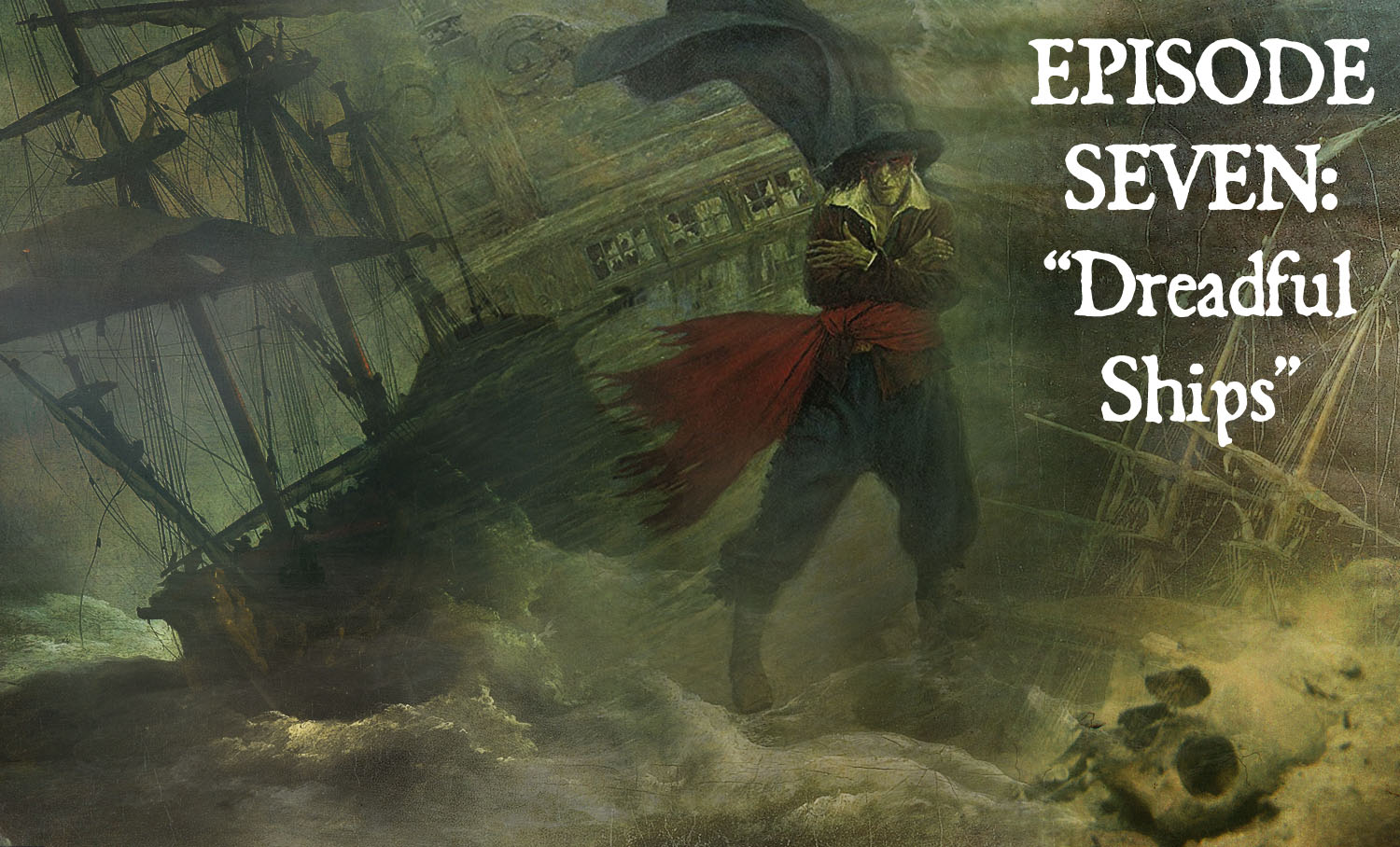
Podcast: Play in new window | Download (Duration: 37:26 — 68.5MB)
Subscribe: Apple Podcasts | Spotify | Android | Podchaser | RSS | More
On this episode of Bone and Sickle, we look at the folklore of ghost ships, undead sailors, some nautical elements in gothic literature, a song about a ship piloted by the Devil, and other horror stories of the sea.
We begin with a little reminiscing about our last show on the Pied Piper and a story by George G. Toudouze that I’d wanted to include but didn’t have space for, “Three Skeleton Key,” It features both a ghost ship and a horde of ravenous rats like those devouring the wicked Bishop Hatto in Episode 7. Clips from a 1956 radio dramatization featuring Vincent Price are included.
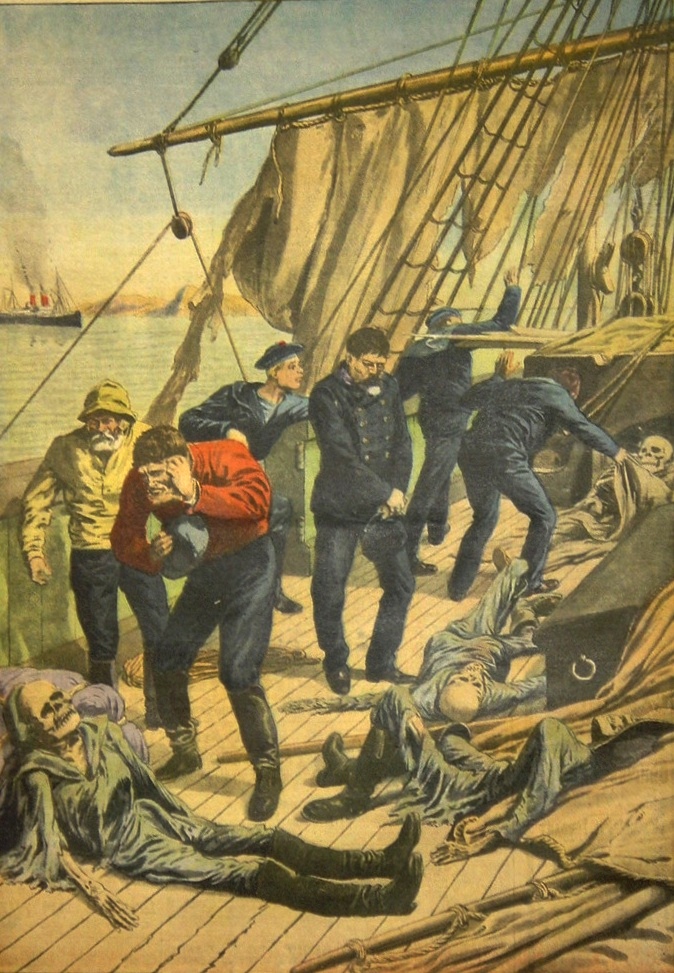
We then take a look at some notorious derelict ships from history, beginning with The Mary Celeste, which entered the popular imagination through a fictionalized account by Arthur Conan Doyle. Ships adrift in the Arctic with frozen crews, a ship cursed by malevolent spirits picked up in Zanzibar, and a ship discovered with its lifeless crew in a particularly grisly state are all discussed.
Edgar Allan Poe, in his only full-length novel, The Narrative of Arthur Gordon Pym of Nantucket, describes a ghost ship in ghastly detail in a passage dramatically interpreted by Wilkinson.
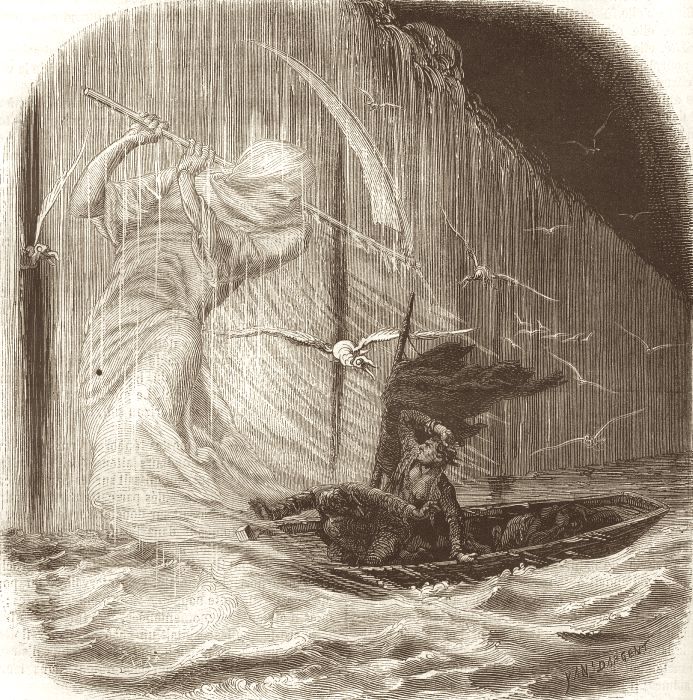
In between the Edgar Allen Poe passage and my introduction to the Flying Dutchman, you heard a snippet of David Coffin and friends singing the sea shanty “Roll the Old Chariot,” which you can hear in its entirety here.
We then have a look at the lore of The Flying Dutchman, best known as the supernatural ship from the Pirates of the Caribbean films or the opera by Richard Wagner, Wilkinson relates some eerie accounts of Dutchman sightings from surprisingly recent times.
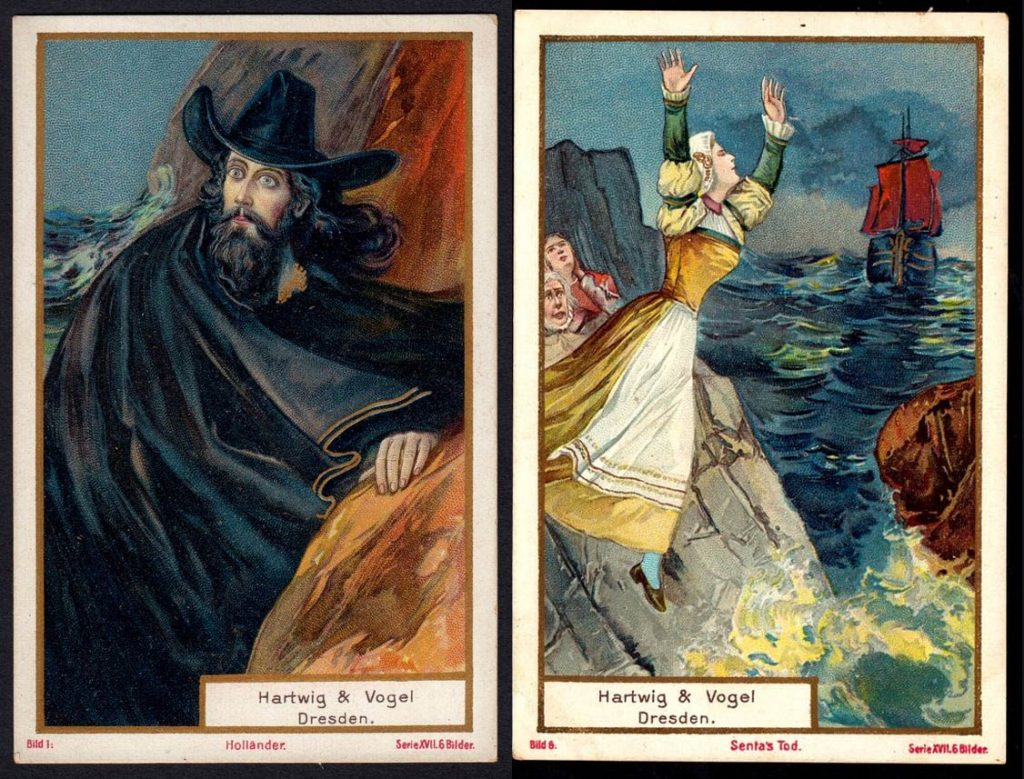
A favorite explanation for stories, in which ghost ship are said to luminesce, is the phenomenon of St. Elmo’s fire, a weird electrical anomaly, which we find showing up everywhere from Melville’s Moby Dick to the laboratory of Nikola Tesla.
Ghost ships are sometimes said to arrive as omens of death, or their appearance may recreate the tragic end of ship and crew. These otherworldly aspects have been noted in mariners’ accounts and served as the basis for a few poems, including a work by Longfellow, which we’ll hear. Along the way, we learn about the Klabautermann, a strange sea-going gnome said to haunt ships on the Baltic and North Seas.
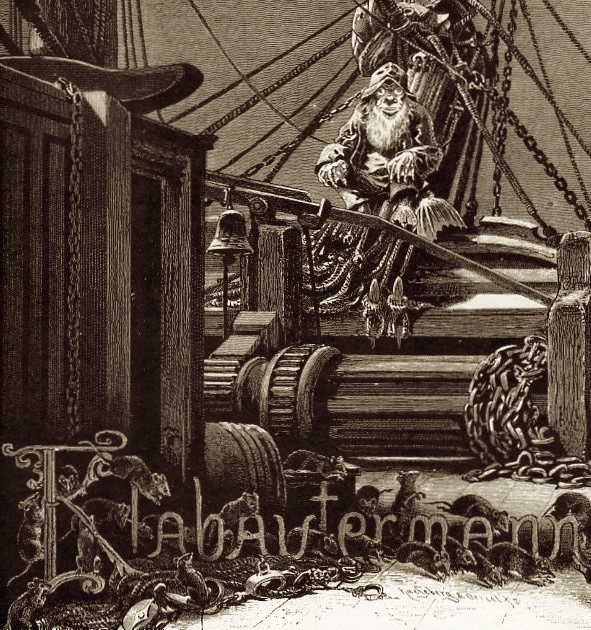
Next, it’s a musical break featuring the 17th-century folk ballad “House Carpenter” also sometimes called “The Daemon Lover.” This tale of demonic jealousy or the Devil’s retribution on the high seas is hauntingly rendered by Appalachian singer Jean Ritchie, Scottish singer A.L Lloyd, and in an instrumental arrangement by Adrian McHenry, and we hear bits of all these versions.
Samuel Coleridge’s epic poem “The Rime of the Ancient Mariner” has often drawn comparison to the Flying Dutchman legend. We have a look at its undead sailors, ominous allegorical figures, and how its arctic setting may have influenced Mary Shelley’s Frankenstein.
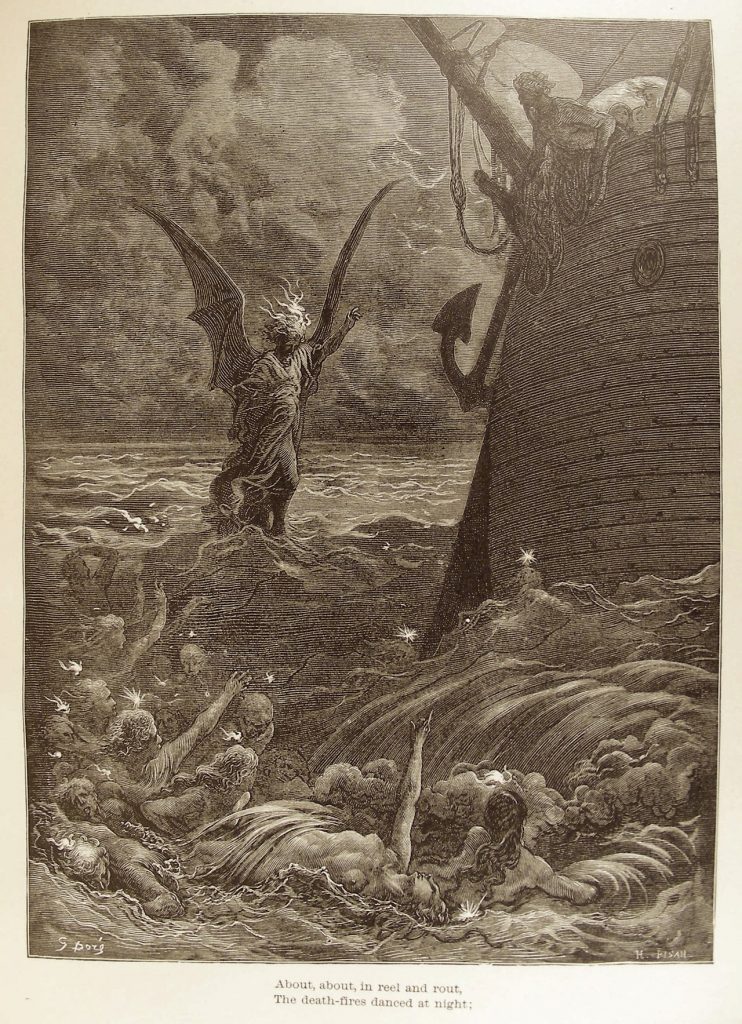
And who would’ve known, but it seems there’s a peculiar link between Bram Stoker’s Dracula and Richard Wagner’s The Flying Dutchman. I work it all out in the conclusion of the episode.
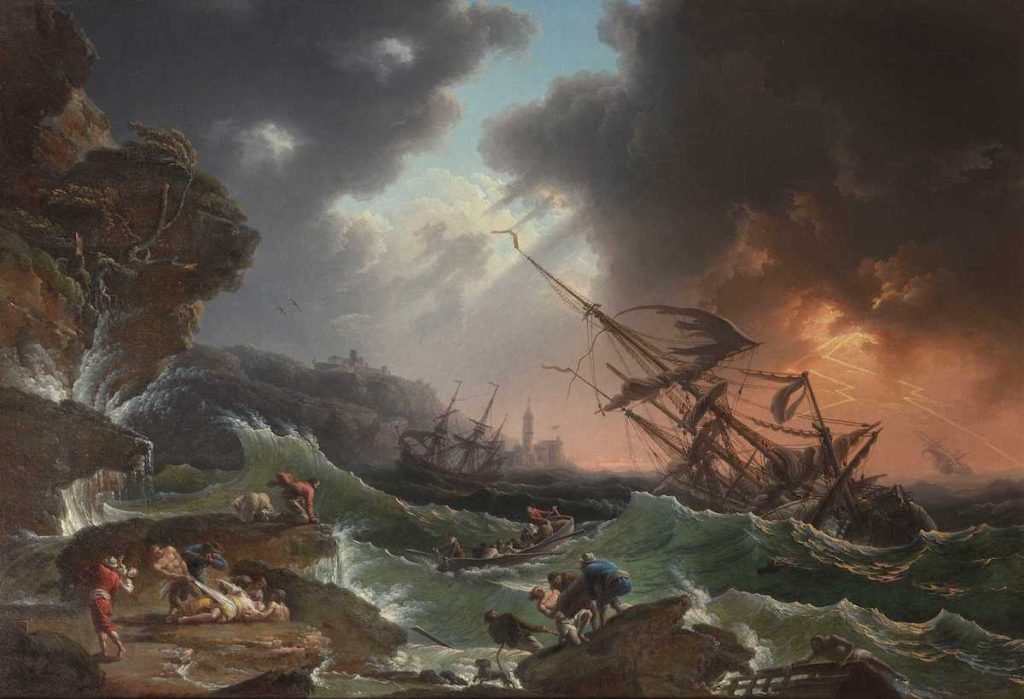
Our ninth episode upcoming August 6 will look at witches of a subterranean bent. (And our eighth on July 23 will be nautical horrors: “Dreadful Ships.”
Subscribe now so you don’t miss them!
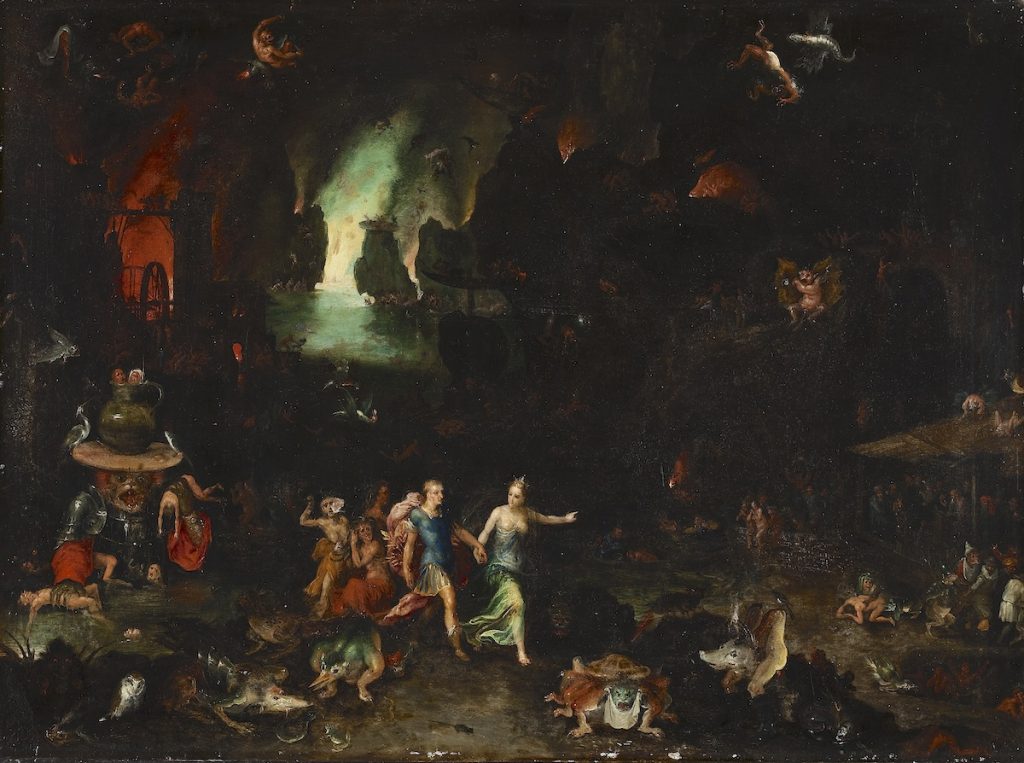
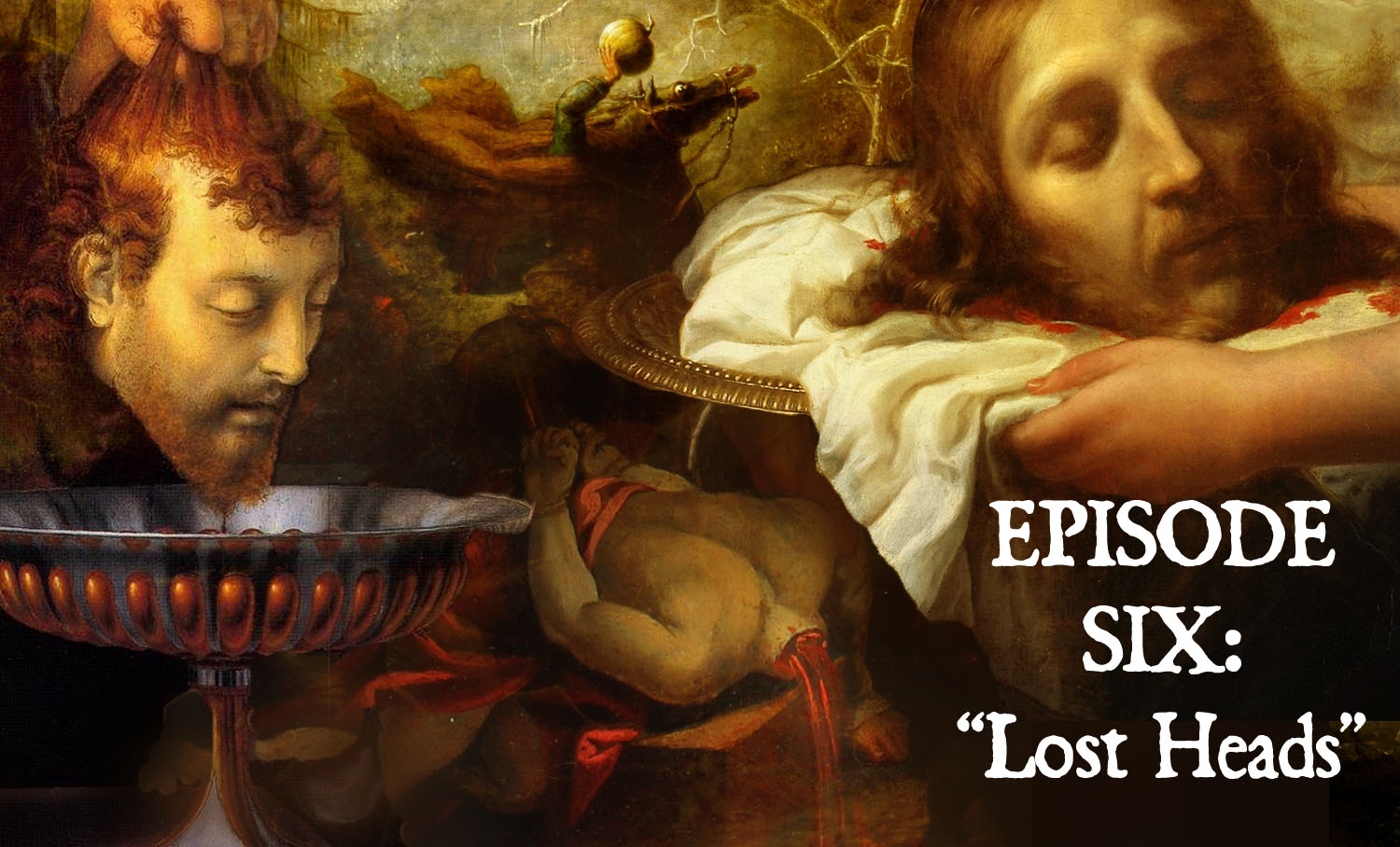
Podcast: Play in new window | Download (Duration: 41:22 — 75.7MB)
Subscribe: Apple Podcasts | Spotify | Android | Podchaser | RSS | More
As June 24, the feast of St. John the Baptist approaches, the folklore of decapitation suggested itself as an appropriate theme for this episode. We begin by way of an old English children’s rhyme and game, “Oranges and Lemons” based on melody played by the bells of St. Clemens church in London. The rhyme ends with the couplet:
Here comes a candle to light you to bed
And here comes a chopper to chop of your head
Chip chop chip chop the last man is dead
… which should explain our inclusion here. We hear this melody (played by local bagpipers) during a procession in the 1973 folk-horror classic The Wicker Man. In the film,the tune accompanies a mock beheading game that the director borrowed from a traditional sword dance, one particularly well preserved in the south Yorkshire town of Grenoside.
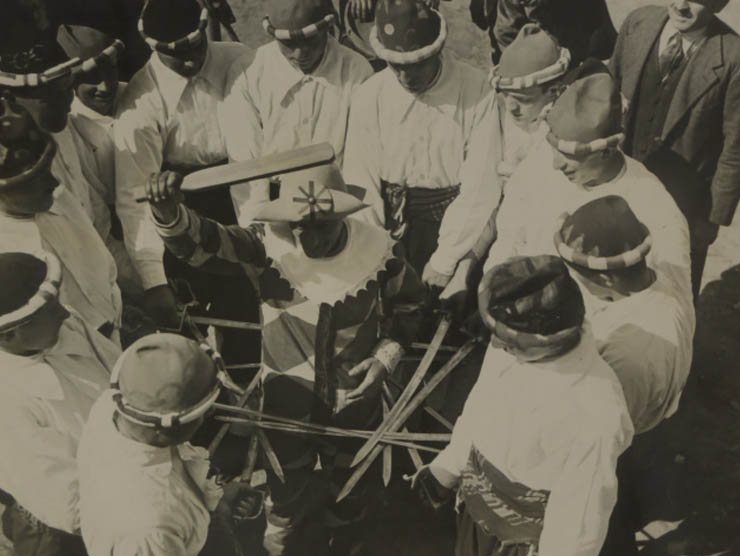
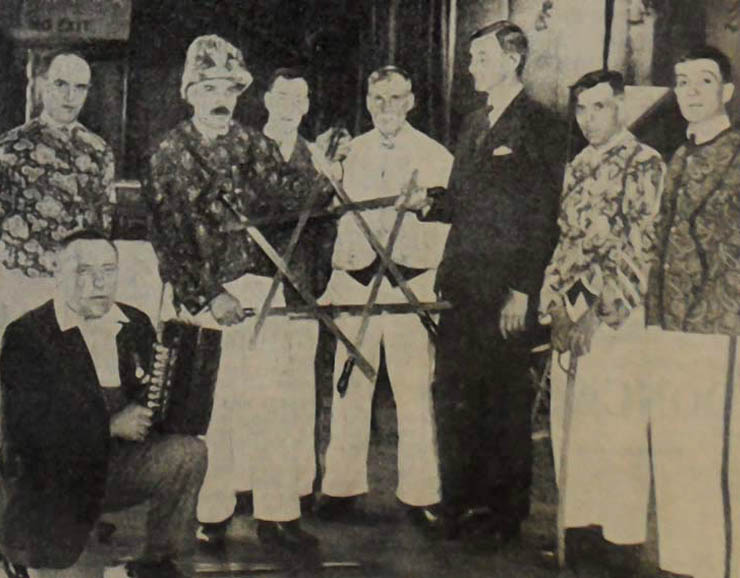
We then review the John the Baptist story, how Salome offers a very pleasing “Dance of the Seven Veils” to King Herod, receiving in gratitude for the performance, a reward of her choosing, Thanks to Salome’s mother, Herodias, the reward chosen is the head of John the Baptist’s. We learn a bit more Herodias, and hear a delightful tale (or tales) of divine punishment she received as well as her late medieval association with the folklore of witchcraft.
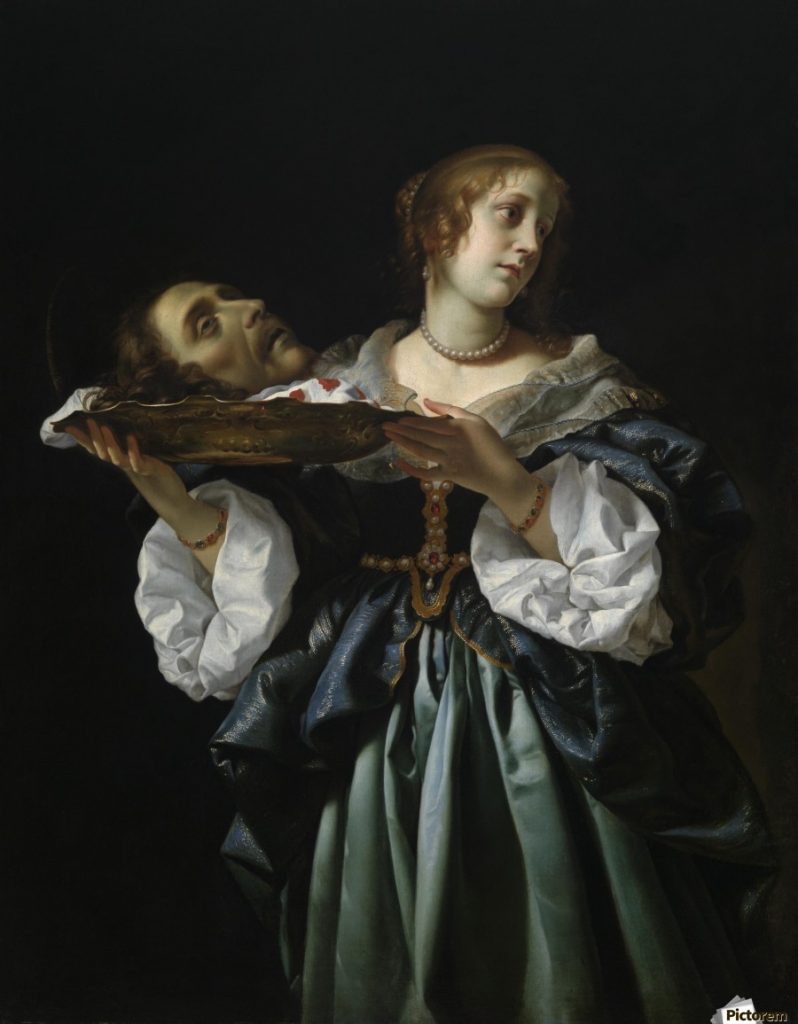
Next we move on the to the discussion of cephalaphores, or saints who suffer decapitation but stubbornly refuse to die, instead traipsing about holding their severed heads. We discuss the cephalaphores St. Denis, St. Edmund (who’s head was guarded by a remarkably tame wolf) and St. Winifred, better known for her holy well.
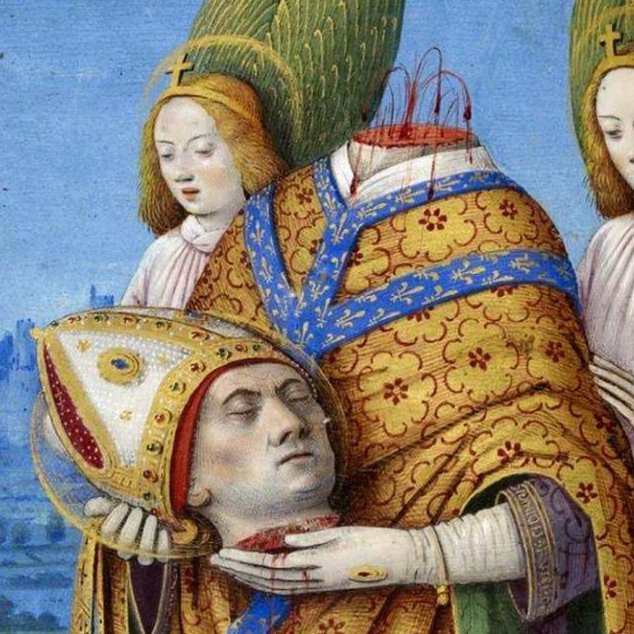
As it turns out, holy wells, which are particularly prominent in Wales, are also associated with severed human heads — more often than one might expect. Some examples and a likely a explanation are offered, and we learn which holy well until recently afforded the visitor the opportunity to employ a saintly skull as a dipper.
Wouldn’t you know it but the topic of magic wells and heads somehow brings us back to The Wicker Man as we learn about a connection between a song in the film and a fairly obscure Elizabethan drama rich in songs, spells, and fairy stories.
We then return to head-chopping games, and one suggested by a mysterious green stranger who appears at King Arthur’s Christmas feast in the tale of Sir Gawain and the Green Knight. Also mentioned is a cinematic treatment of the tale, 1984’s Sword of the Valiant, featuring Sean Connery in an outlandish costume that almost gives his wardrobe in Zardoz a run for its money.
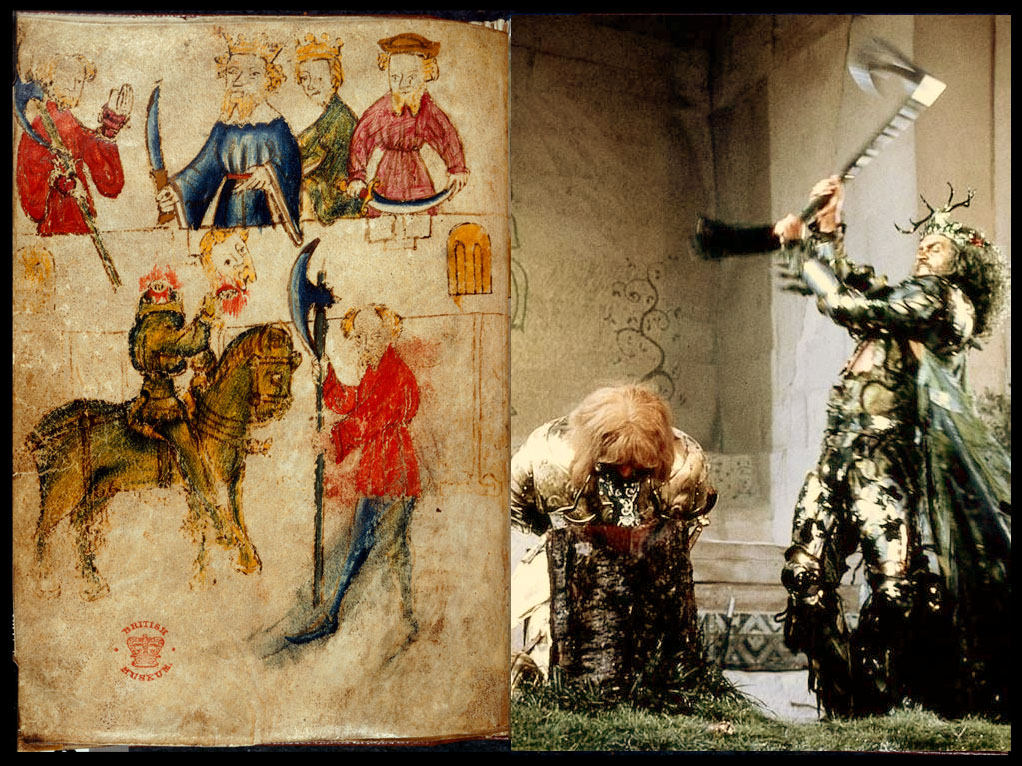
Even though it’s already well known, it seemed wrong to omit Washington Irving’s The Legend of Sleepy Hollow and its headless horseman. Wilkinson seemed particularly eager to discuss it, so we leave that to him (with more than a little help in the sound effects department.)
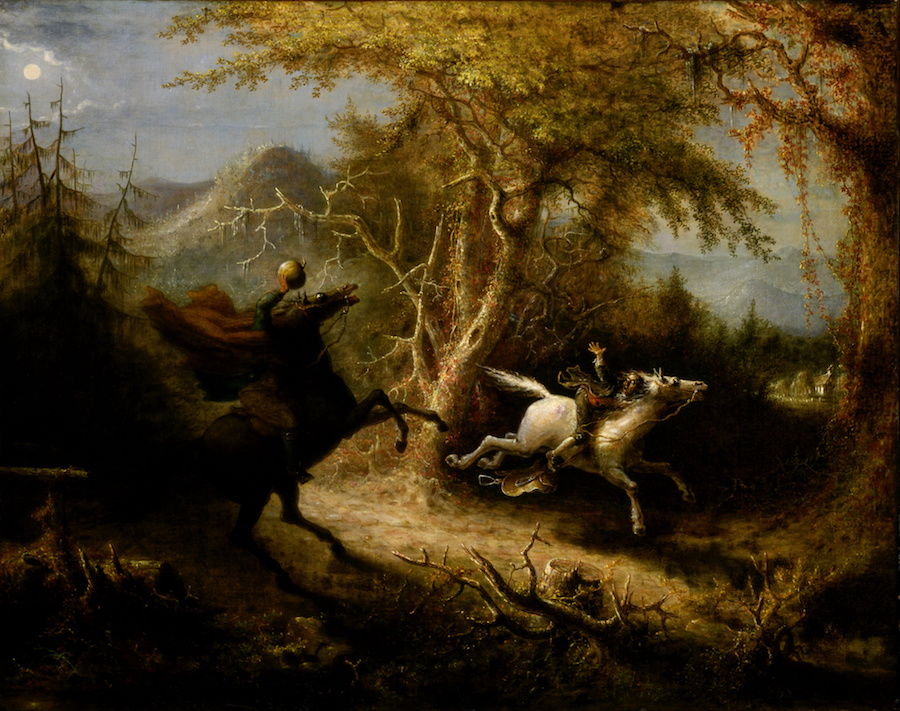
Scotland offers our next two stories, one which tells of a sort of headless horseman of the Highlands (and some fortune-telling butter) and the other of Mary Queen of Scots badly botched beheading.
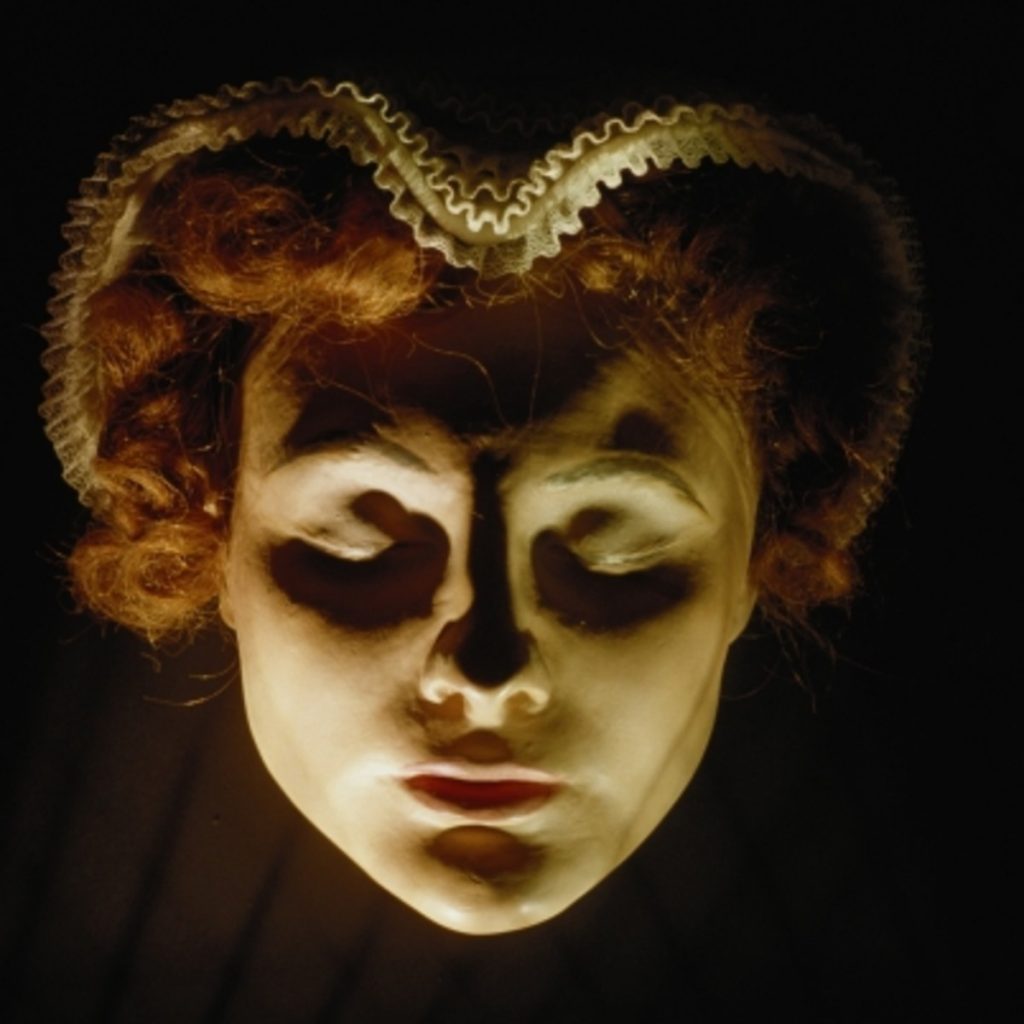
Then it’s back to Wales for the story of Bran the Blessed, a mythological king, whose (not quite dead) head was quite the entertainer and ended up buried under the Tower of London once it shut up. The execution of Anne Boleyn also gets a nod with macabre ditty from 1934 about her headless ghost.
If you find yourself horrified by the obsession with heads and head-chopping in these Celtic nations, you are not alone. Classical writers also were appalled by decapitation fixations of the northern tribes. We hear some choice words on the subject, read by Wilkinson. We also learn about a bizarre super-weapon employed by Celtic warriors — “brain balls” — and how they figure into a story of a newly converted Celtic chieftain.
The Germanic tribes too had a loose head or two in their mythology. Hear the story of Mimir, whose decapitated head Odin preserved and relied upon for counsel.
We close the show with some talk of magicians (an alchemist and a supposedly wicked pope) who created their own “brazen heads” intended to likewise offer advice or prognostication.
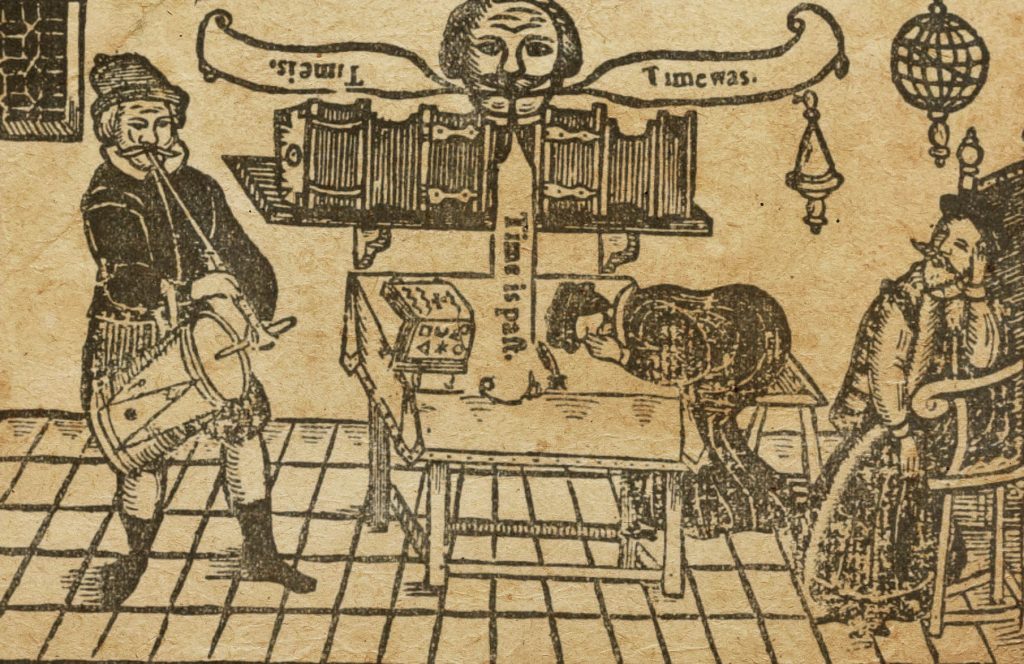
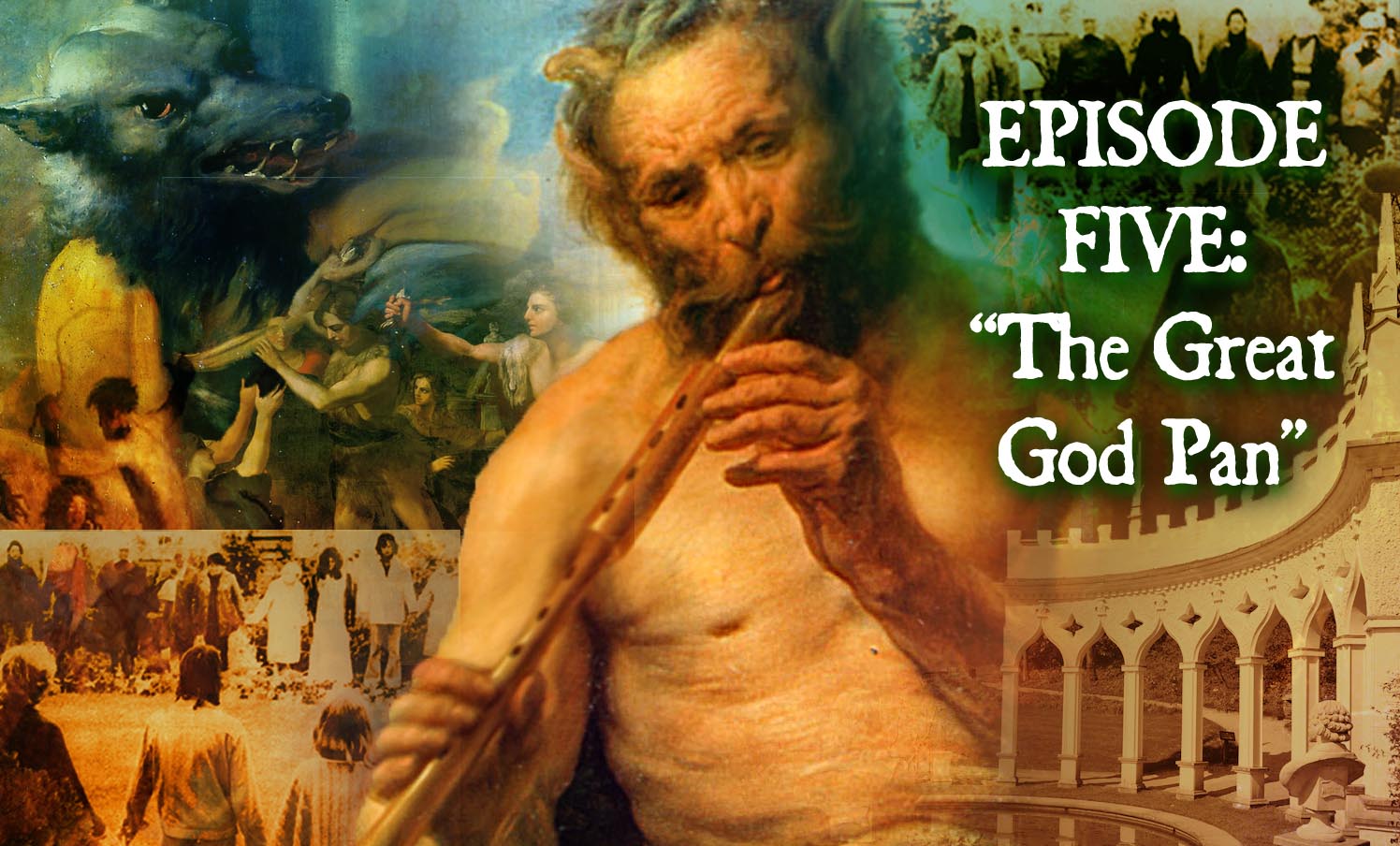
Podcast: Play in new window | Download (Duration: 36:34 — 33.5MB)
Subscribe: Apple Podcasts | Spotify | Android | Podchaser | RSS | More
We follow our previous episode on the god Pan with a second this week, delving even deeper into the creative and bizarre ways the figure has been embraced after his much publicized “death.”
Our first several minutes are devoted to literary explorations of Pan in the decades around World War I. Naturally we examine only writers providing the more fantastic or horrific examples, including the creator of the high fantasy genre Anglo-Irish writer Edward John Moreton Drax Plunkett, the 18th Baron Dunsany (aka Lord Dunsany). In The Blessings of Pan, he imagines ancient rites to Pan resurrected in the England of his day. If you like what you hear, you might want to have listen to another one of his stories narrated by Vincent Price here.
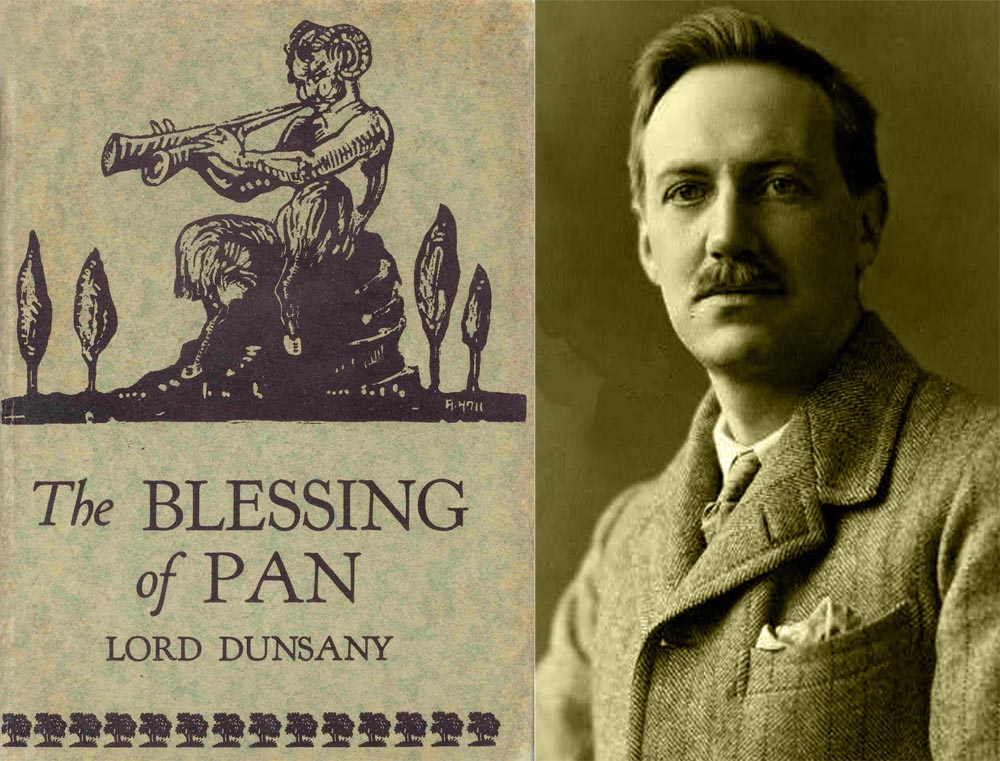
Wilkinson also provides us a reading from “The Music on the Hill,” by writer Hector Munro, who wrote under the name “Saki”. There is a spoiler in the reading, but it’s pleasingly grisly. We make up for the spoilage by providing you this additional unsettling, darkly comic (to us) story by Saki, one in which a defiant young boy decides to provoke his caretaker by creating a religion around his ferret, whom he names “Sredni Vashtar.” As it turns out, the ferret proves to be a dreadfully vindictive god.
But I digress.
As it turns out, the idea of a return to pagan Pan worship in the Christian era written about by Dunsany and others, may be more than simply a matter of fiction. Our next segment deals with such a case. In 18th-century England, in the town of Painswick, England, a member of the gentry, one Benjamin Hyett, was known to have built “an Arcadian retreat” featuring a building known as “Pan’s Lodge.” You can have a look here at a contemporaneous painting of the lodge grounds and Hyett’s statue (one of two — the other met a curious fate).
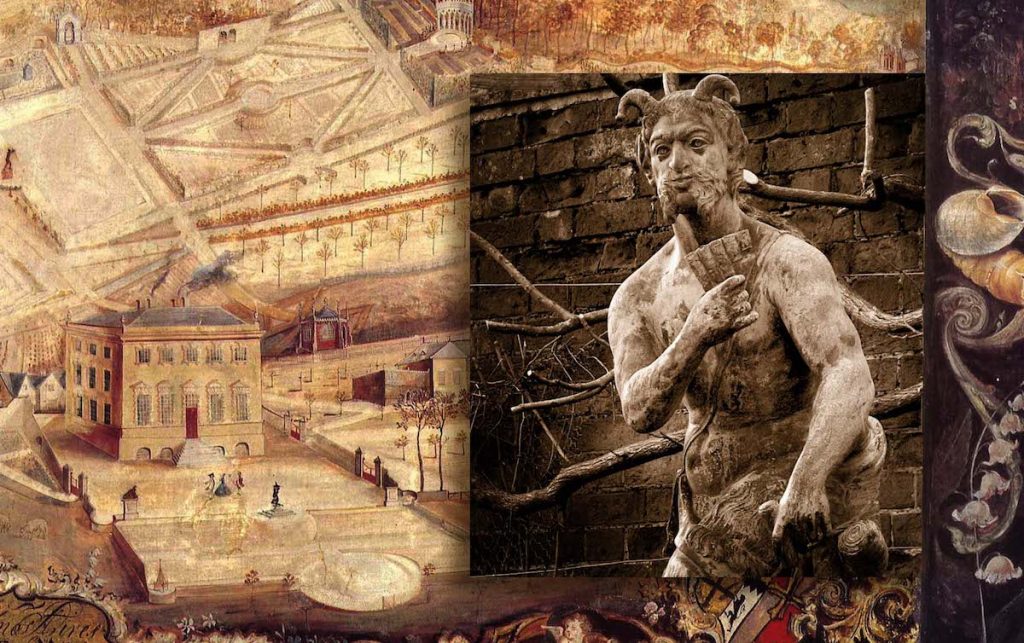
Hyett eventually brought the entire community around to join in these rites to Pan. The story grows more complex and curious as these rites are resurrected roughly a century later by a priest who, as we learn, had some intriguing notions about their meaning and origin. Entangled within this story are other local oddities of Painswick culture, including a dish known as “Puppy Dog Pie,” and a practice known as “clipping the church” or “church clipping,” in which members of the congregation join hands and perambulate their place of worship.

Somehow we then arrive at the topic of Lupercalia, the Roman festival involving priests dressed in nothing chasing the Roman woman through the streets with whips. Oddly enough this topic brings us back to Arcadia, home of Pan.

Lupercalia brings us to some interesting myths and tales related to the Arcadian festival Lykaia and King Lycaon, whom Zeus transformed into a wolf (history’s first werewolf, some would say.) Find out what loathsome act drove Zeus to take this action as Wilkinson provides another excellent reading from Ovid.
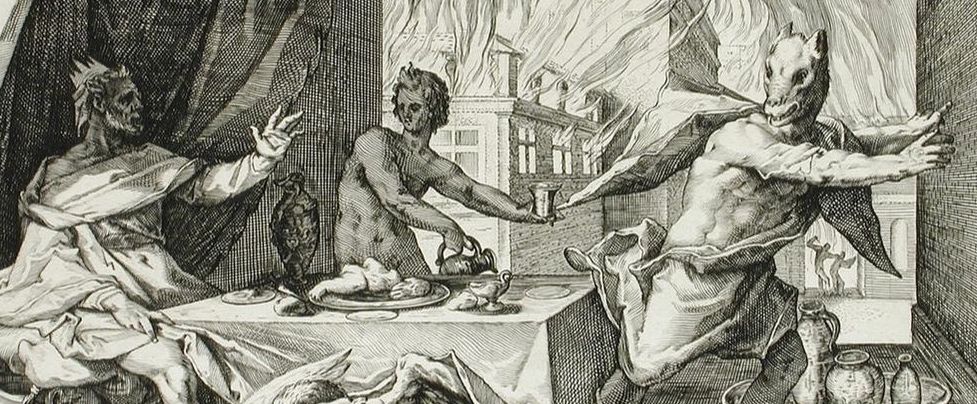
A bit more ancient Greek werewolf lore, a ghastly story about Pan and his ill-fated pursuit of the nymph Echo, and we end up — of all places — on Summerisle, that is, talking again about The Wicker Man, as we are wont to do. Somehow, the Wicker Man leads us back to Pan. You’l have to just trust me on this.
Benjamin Hyett, was not alone in resurrecting the notion of Pan worship. We find religious devotion to Pan and other pagan nature spirits (as well as inexplicably thriving vegetables) at Northern Scotland’s Findhorn Community. Some clips from a 1973 BBC show make clear their roots in the hippy culture of the era, giving us a bit of background before we meet Findhorn’s primary acolyte of Pan, Robert Ogilvie Crombie (aka ROC). His encounters with Pan in 1970s Edinburgh bring up an interesting point about the difficulties of directly encountering Pan. And naturally, this brings us to our next and final topic.
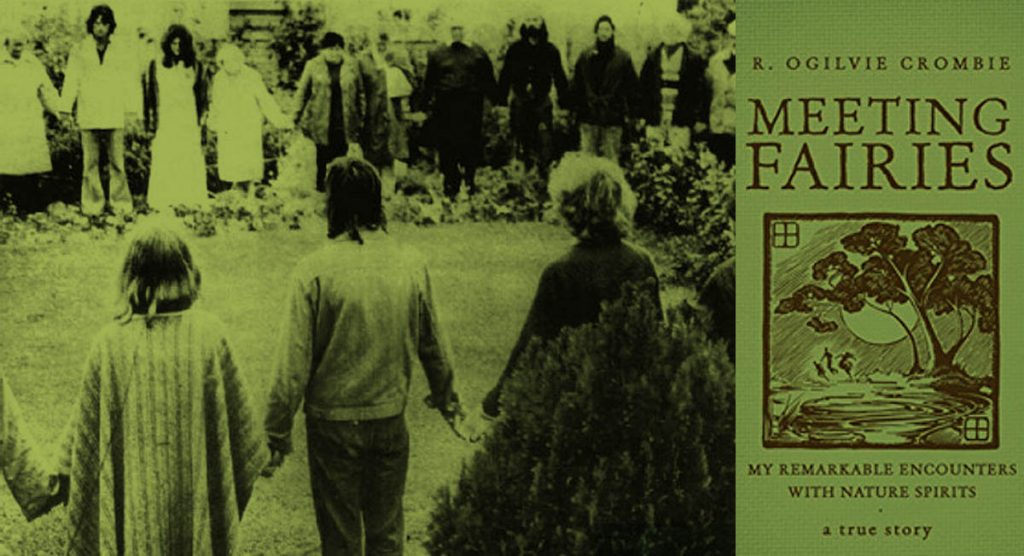
Arthur Machen’s 1890 horror novel, The Great God Pan was highly influential not only to Lovecraft, but other writers in his circle, and in general on the genre variously identified as “weird fiction” or “cosmic horror.” Neil Gaiman, Guillermo Del Toro, and Arthur C. Clarke have all praised the story. Stephen King has called it “one of the best horror stories ever written. Maybe the best in the English language.”
Once again Wilkinson provides a couple readings of wonderfully morbid passages from the book complete with the usual Bone and Sickle audio ambiance.
We go out with the song “The Great God Pan” from the soundtrack to Mondo Hollywood, a 1967 a documentary in the “mondo” style presenting a mix of LA celebrities and countercultural oddballs, heavy on the oddballs.
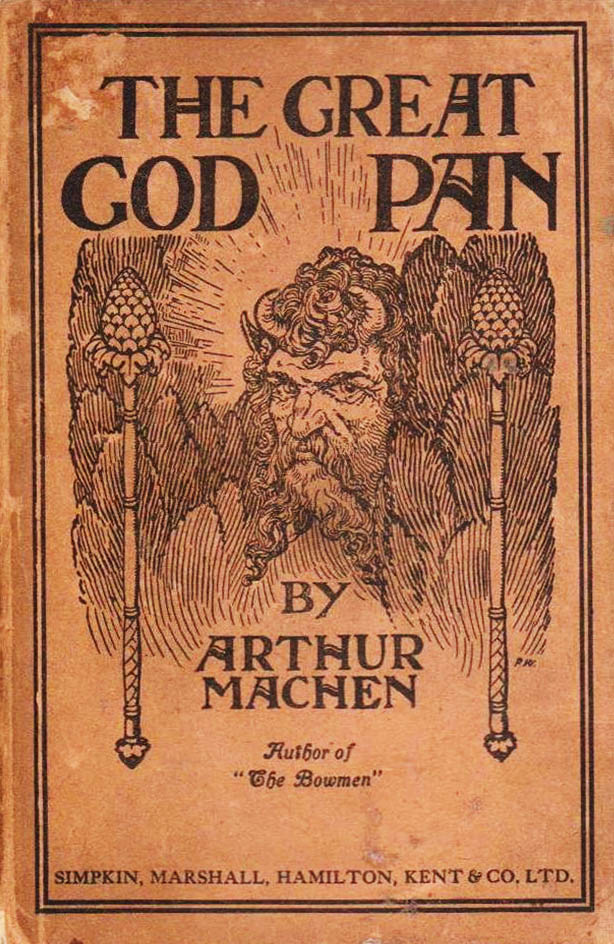
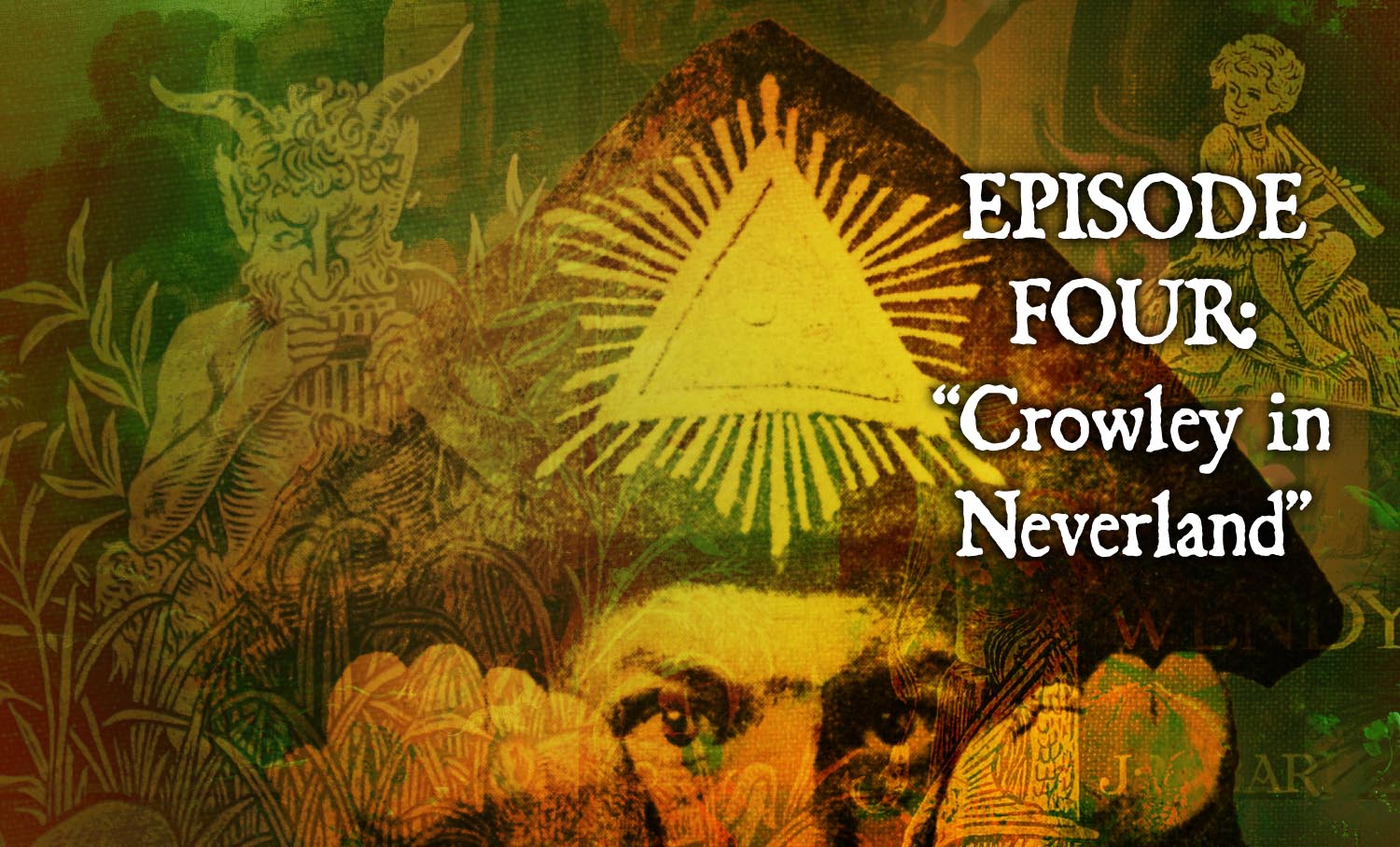
Podcast: Play in new window | Download (Duration: 38:03 — 34.8MB)
Subscribe: Apple Podcasts | Spotify | Android | Podchaser | RSS | More
The devilish appearance of the Greek god Pan has fascinated artists, occultists, and others straying from the path for centuries. This episode begins with some tales of Pan in his natural habitat of Arcadia, how the Greeks, and later Romans, saw him, and some of his central myths — what tragedy resulted in the creation of panpipes and what did that naughty “happy to see me” phallus signify? And his much publicized death during the reign of Tiberius Caesar; what did that mean to the evolving Christian world?
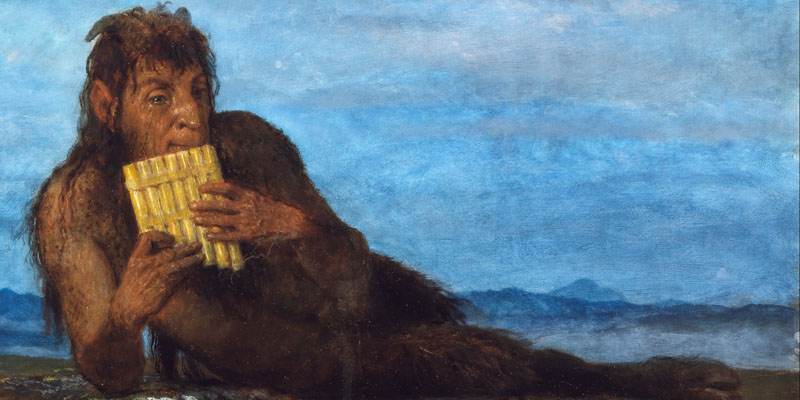
Like Mark Twain, said of his own demise, reports of Pan’s death seem greatly exaggerated.
The Romantics embraced Pan as a symbol of a lost but harmonious pastoral past, while figures in the 19th-century Occult Revival began to celebrate him in a different way, one based, on similarities between Pan and the iconography of the Christian Devil. Tracing the figure of Satan directly back to Pan, however, presents difficulties — including technical difficulties in this episode. We apologize for any disruptions and are working to ensure that our production process in future offers more robust resistance to demonic influence.
The culture of the Victorian and Edwardian era was particularly obsessed with Pan. A particularly sinister example of this would be found in Aleister Crowley, who declared his “Hymn to Pan” the “most powerful enchantment ever written.” We learn its dark origins, a scandal it caused at the Great Beast’s funeral, and even have a listen to a snippet — a rare and dramatic recording made in 1987 during aThelemic ceremony in which Pan is invoked using Crowley’s text.
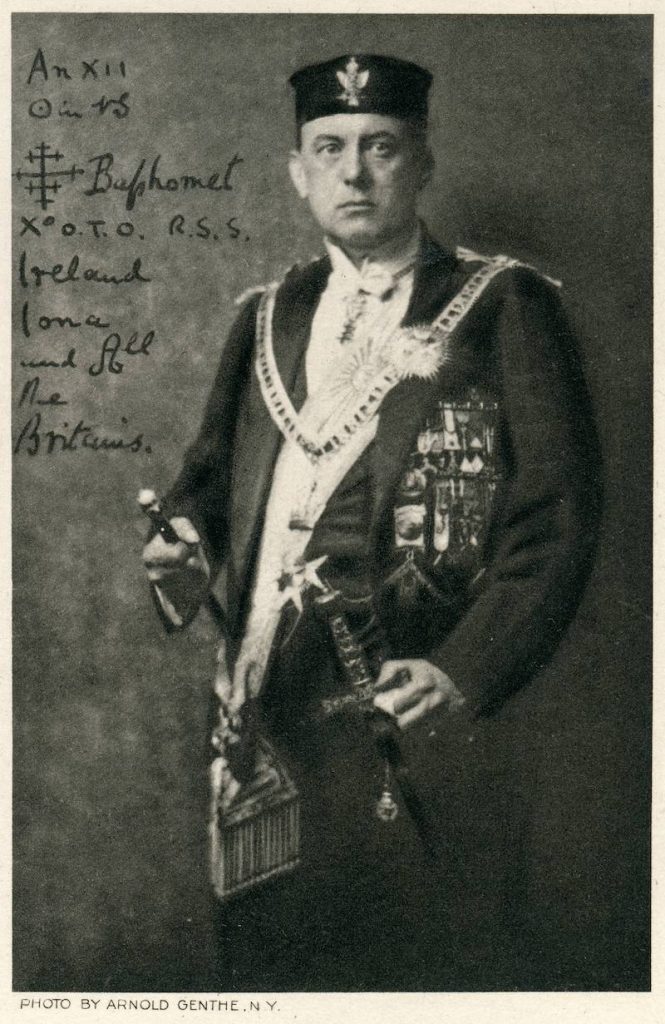
Also discussed is Pan’s role in Wicca and his relationship/rivalry with Cernunnos and Herne the Hunter, as well as the influence individuals like the writer Margaret Murray and Wicca’s grandaddy Gerald Gardner exercised on this.
We lighten up a bit with the story of the eccentric “Priest of Pan” from the town of Millinocket, Maine, and how he made the news in 2016.
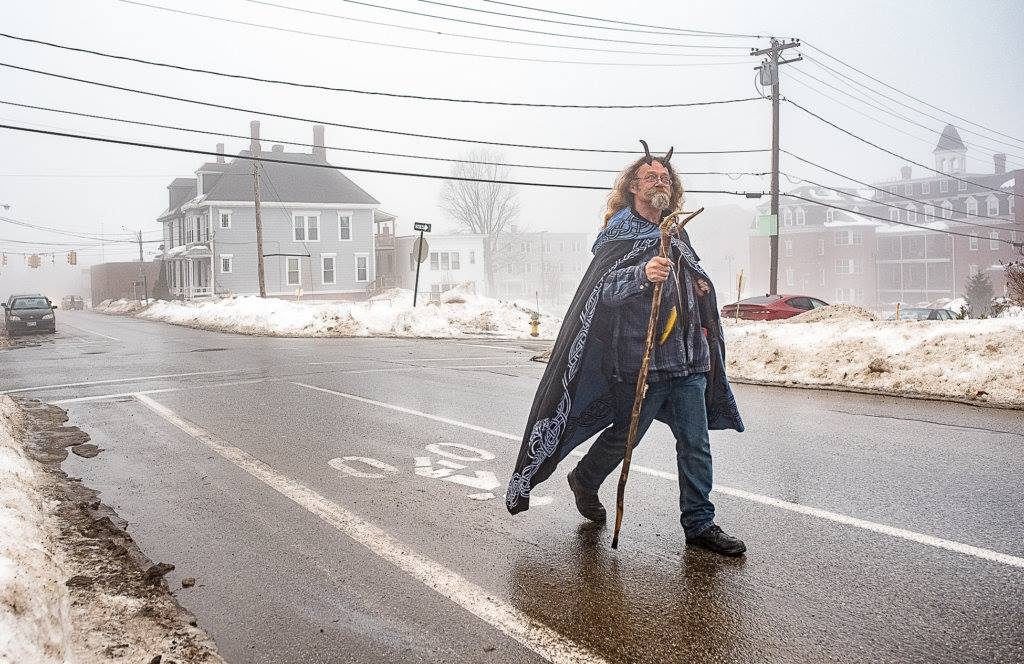
On the other side of Edwardian culture there were writers like J.M. Barrie, creator of Peter Pan and Kenneth Grahame (Wind in the Willows) who exhibited a more benign fascination with the the pagan god. But even here, we trace some dark roots.
We’ll also learn something of H.P. Lovecraft’s childhood devotion to Pan and other Greek gods. Somehow Lovecraft seems to hover around the fringes of this episode, and particularly the next.
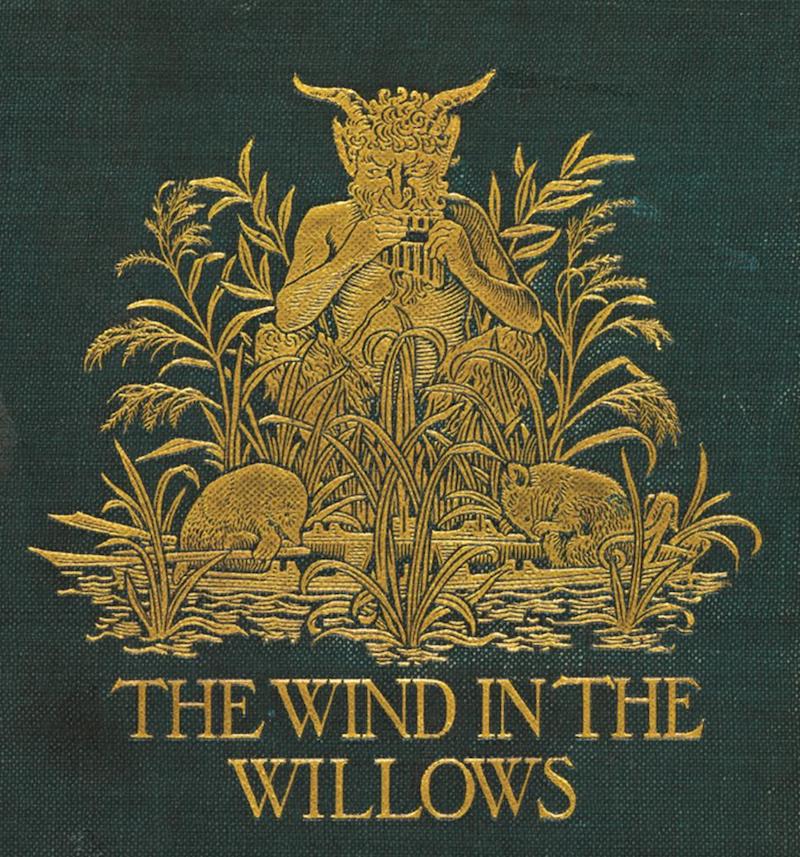
Finally we arrive in Neverland with a brief exploration of J.M. Barrie’s Peter Pan, learning something of the troubled life of the author who gave birth to the character.
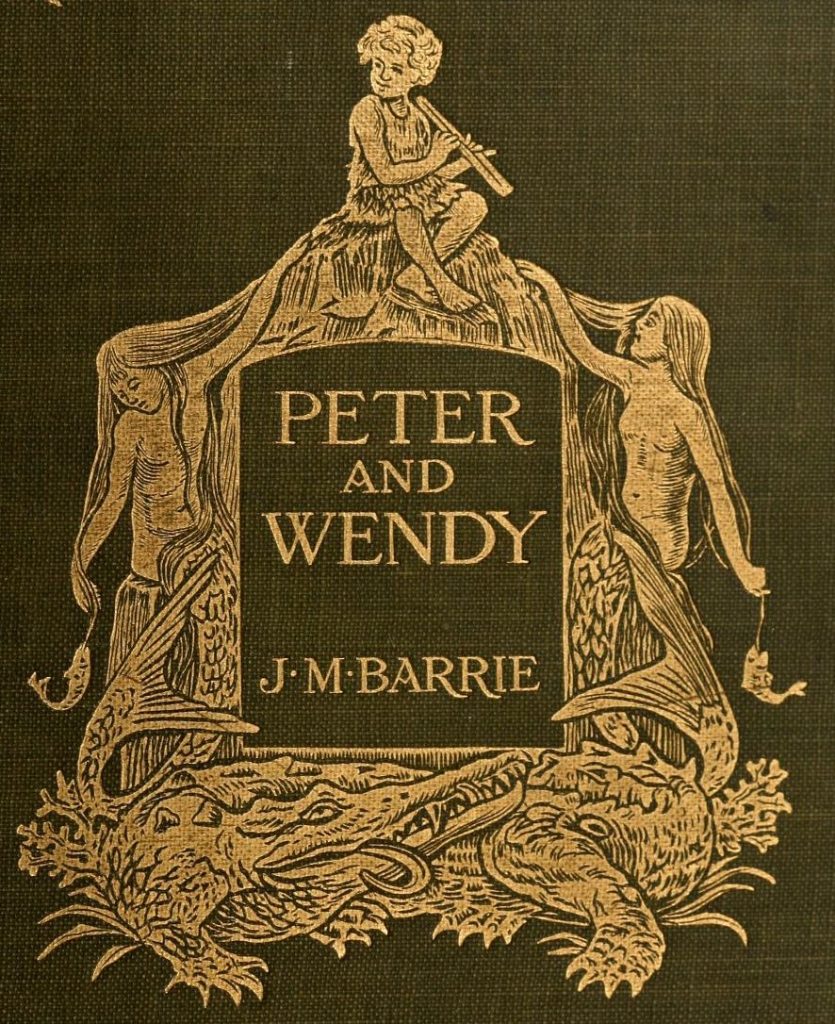
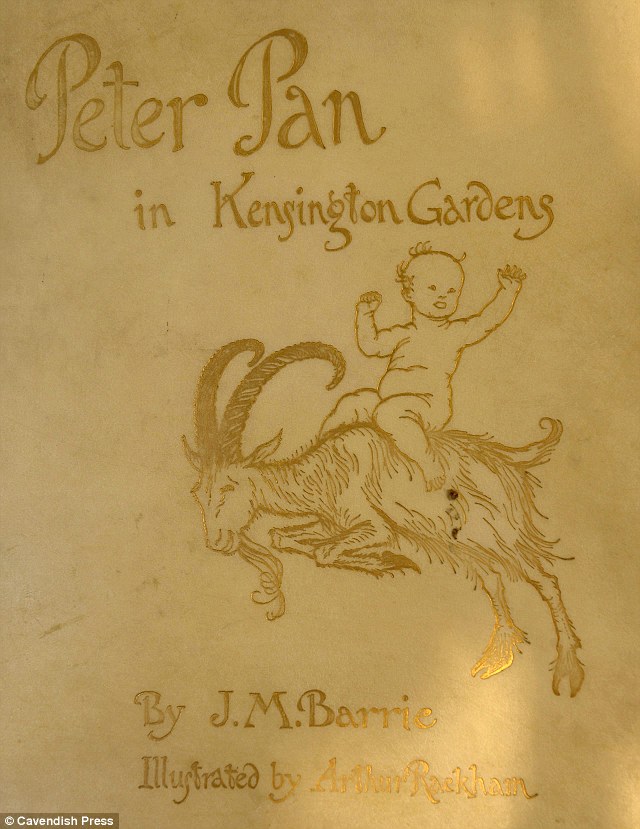
We end the show with something creepy, some news reporters talking about a haunted bridge in Kentucky. Yes, it has something to do with Pan. A bit.

A NOTE ON MUSIC: The music you hear beneath the narration on “Bone and Sickle” consists almost entirely of original compositions. In this and the following episode, however, you may hear a percussion loop sampled from — LVDI SCÆNICI (“Ludi Scaenici” or “stage games”), an interesting Italian group recreating the music of ancient Rome. Listeners may enjoy checking out more of their work, such as this video of one of their performances.